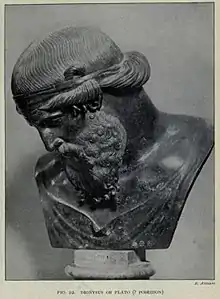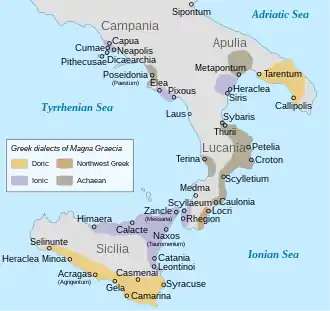Plato
Plato (/ˈpleɪtoʊ/ PLAY-toe;[2] Greek: Πλάτων Plátōn; 428/427 or 424/423 – 348/347 BC) was a Greek philosopher born in Athens during the Classical period in Ancient Greece. He founded the Platonist school of thought and the Academy, the first institution of higher learning on the European continent.
Plato | |
|---|---|
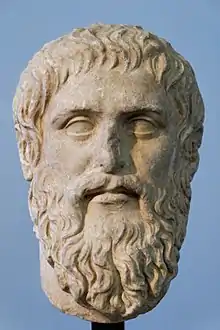 Roman copy of a portrait bust c. 370 BC | |
| Born | 428/427 or 424/423 BC |
| Died | 348/347 BC (aged c. 80) Athens, Greece |
| Notable work | |
| Era | Ancient Greek philosophy |
| Region | Western philosophy |
| School | Platonism |
| Notable students |
|
Main interests | |
Notable ideas | Platonism
Theoretical philosophy
Practical philosophy
|
Influences
| |
Influenced
| |
| Part of a series on |
| Platonism |
|---|
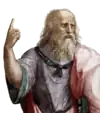 |
|
| Allegories and metaphors |
| Related articles |
|
| Related categories |
|
Plato |
|
Along with his teacher, Socrates, and his student, Aristotle, Plato is a central figure in the history of Ancient Greek philosophy and the Western and Middle Eastern philosophies descended from it.[lower-alpha 1] He has also shaped religion and spirituality.[5] The so-called neoplatonism of his interpreter Plotinus greatly influenced both Christianity (through Church Fathers such as Augustine) and Islamic philosophy (through e.g. Al-Farabi). In modern times, Friedrich Nietzche diagnosed Western culture as growing in the shadow of Plato (famously calling Christianity "Platonism for the masses"), while Alfred North Whitehead noted: "the safest general characterization of the European philosophical tradition is that it consists of a series of footnotes to Plato."[6]
Plato was an innovator of the written dialogue and dialectic forms in philosophy. He raised problems for what later became all the major areas of both theoretical philosophy and practical philosophy. His most famous contribution is the theory of Forms known by pure reason, in which Plato presents a solution to the problem of universals, known as Platonism (also ambiguously called either Platonic realism or Platonic idealism). He is also the namesake of Platonic love and the Platonic solids.
His own most decisive philosophical influences are usually thought to have been, along with Socrates, the pre-Socratics Pythagoras, Heraclitus and Parmenides, although few of his predecessors' works remain extant and much of what we know about these figures today derives from Plato himself.[lower-alpha 2] Unlike the work of nearly all of his contemporaries, Plato's entire body of work is believed to have survived intact for over 2,400 years.[8] Although their popularity has fluctuated, Plato's works have consistently been read and studied.[9]
Biography
Birth and family
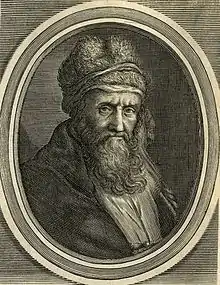
Little is known about Plato's early life and education. He belonged to an aristocratic and influential family. According to a disputed tradition, reported by doxographer Diogenes Laërtius, Plato's father Ariston traced his descent from the king of Athens, Codrus, and the king of Messenia, Melanthus.[10] According to the ancient Hellenic tradition, Codrus was said to have been descended from the mythological deity Poseidon.[11][12]
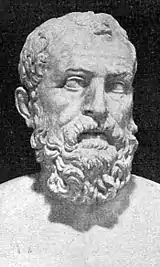
Plato's mother was Perictione, whose family boasted of a relationship with the famous Athenian lawmaker and lyric poet Solon, one of the seven sages, who repealed the laws of Draco (except for the death penalty for homicide).[12] Perictione was sister of Charmides and niece of Critias, both prominent figures of the Thirty Tyrants, known as the Thirty, the brief oligarchic regime (404–403 BC), which followed on the collapse of Athens at the end of the Peloponnesian War (431–404 BC).[13] According to some accounts, Ariston tried to force his attentions on Perictione, but failed in his purpose; then the god Apollo appeared to him in a vision, and as a result, Ariston left Perictione unmolested.[14]
The exact time and place of Plato's birth are unknown. Based on ancient sources, most modern scholars believe that he was born in Athens or Aegina[lower-alpha 3] between 429 and 423 BC, not long after the start of the Peloponnesian War.[lower-alpha 4] The traditional date of Plato's birth during the 87th or 88th Olympiad, 428 or 427 BC, is based on a dubious interpretation of Diogenes Laërtius, who says, "When [Socrates] was gone, [Plato] joined Cratylus the Heracleitean and Hermogenes, who philosophized in the manner of Parmenides. Then, at twenty-eight, Hermodorus says, [Plato] went to Euclides in Megara." However, as Debra Nails argues, the text does not state that Plato left for Megara immediately after joining Cratylus and Hermogenes.[24] In his Seventh Letter, Plato notes that his coming of age coincided with the taking of power by the Thirty, remarking, "But a youth under the age of twenty made himself a laughingstock if he attempted to enter the political arena." Thus, Nails dates Plato's birth to 424/423.[25]
According to Neanthes, Plato was six years younger than Isocrates, and therefore was born the same year the prominent Athenian statesman Pericles died (429 BC).[26] Jonathan Barnes regards 428 BC as the year of Plato's birth.[22][23] The grammarian Apollodorus of Athens in his Chronicles argues that Plato was born in the 88th Olympiad.[19] Both the Suda and Sir Thomas Browne also claimed he was born during the 88th Olympiad.[18][27] Another legend related that, when Plato was an infant, bees settled on his lips while he was sleeping: an augury of the sweetness of style in which he would discourse about philosophy.[28]
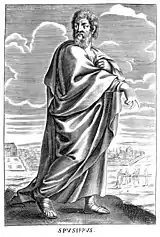
Besides Plato himself, Ariston and Perictione had three other children; two sons, Adeimantus and Glaucon, and a daughter Potone, the mother of Speusippus (the nephew and successor of Plato as head of the Academy).[13] The brothers Adeimantus and Glaucon are mentioned in the Republic as sons of Ariston,[29] and presumably brothers of Plato, though some have argued they were uncles.[lower-alpha 5] In a scenario in the Memorabilia, Xenophon confused the issue by presenting a Glaucon much younger than Plato.[31]
Ariston appears to have died in Plato's childhood, although the precise dating of his death is difficult.[32] Perictione then married Pyrilampes, her mother's brother,[33] who had served many times as an ambassador to the Persian court and was a friend of Pericles, the leader of the democratic faction in Athens.[34] Pyrilampes had a son from a previous marriage, Demus, who was famous for his beauty.[35] Perictione gave birth to Pyrilampes' second son, Antiphon, the half-brother of Plato, who appears in Parmenides.[36]
In contrast to his reticence about himself, Plato often introduced his distinguished relatives into his dialogues or referred to them with some precision. In addition to Adeimantus and Glaucon in the Republic, Charmides has a dialogue named after him; and Critias speaks in both Charmides and Protagoras.[37] These and other references suggest a considerable amount of family pride and enable us to reconstruct Plato's family tree. According to Burnet, "the opening scene of the Charmides is a glorification of the whole [family] connection ... Plato's dialogues are not only a memorial to Socrates but also the happier days of his own family."[38]
Name
The fact that the philosopher in his maturity called himself Platon is indisputable, but the origin of this name remains mysterious. Platon is a nickname from the adjective platýs (πλατύς) 'broad'. Although Platon was a fairly common name (31 instances are known from Athens alone),[39] the name does not occur in Plato's known family line.[40] The sources of Diogenes Laërtius account for this by claiming that his wrestling coach, Ariston of Argos, dubbed him "broad" on account of his chest and shoulders, or that Plato derived his name from the breadth of his eloquence, or his wide forehead.[41][42] While recalling a moral lesson about frugal living Seneca mentions the meaning of Plato's name: "His very name was given him because of his broad chest."[43]
_(14767984254).jpg.webp)
His true name was supposedly Aristocles (Ἀριστοκλῆς), meaning 'best reputation'.[lower-alpha 6] According to Diogenes Laërtius, he was named after his grandfather, as was common in Athenian society.[44] But there is only one inscription of an Aristocles, an early archon of Athens in 605/4 BC. There is no record of a line from Aristocles to Plato's father, Ariston. Recently a scholar has argued that even the name Aristocles for Plato was a much later invention.[45] However, another scholar claims that "there is good reason for not dismissing [the idea that Aristocles was Plato's given name] as a mere invention of his biographers", noting how prevalent that account is in our sources.[40]
Education
Ancient sources describe him as a bright though modest boy who excelled in his studies. Apuleius informs us that Speusippus praised Plato's quickness of mind and modesty as a boy, and the "first fruits of his youth infused with hard work and love of study".[46] His father contributed all which was necessary to give to his son a good education, and, therefore, Plato must have been instructed in grammar, music, and gymnastics by the most distinguished teachers of his time.[47] Plato invokes Damon many times in the Republic. Plato was a wrestler, and Dicaearchus went so far as to say that Plato wrestled at the Isthmian games.[48] Plato had also attended courses of philosophy; before meeting Socrates, he first became acquainted with Cratylus and the Heraclitean doctrines.[49]
Ambrose believed that Plato met Jeremiah in Egypt and was influenced by his ideas. Augustine initially accepted this claim, but later rejected it, arguing in The City of God that "Plato was born a hundred years after Jeremiah prophesied."[50]
Later life and death
.png.webp)
Plato may have travelled in Italy, Sicily, Egypt, and Cyrene.[51] Plato's own statement was that he visited Italy and Sicily at the age of forty and was disgusted by the sensuality of life there. Said to have returned to Athens at the age of forty, Plato founded one of the earliest known organized schools in Western Civilization on a plot of land in the Grove of Hecademus or Academus.[52] This land was named after Academus, an Attic hero in Greek mythology. In historic Greek times it was adorned with oriental plane and olive plantations[53][54]
The Academy was a large enclosure of ground about six stadia (a total of between a kilometer and a half mile) outside of Athens proper. One story is that the name of the Academy comes from the ancient hero, Academus; still another story is that the name came from a supposed former owner of the plot of land, an Athenian citizen whose name was (also) Academus; while yet another account is that it was named after a member of the army of Castor and Pollux, an Arcadian named Echedemus.[55] The Academy operated until it was destroyed by Lucius Cornelius Sulla in 84 BC. Many intellectuals were schooled in the Academy, the most prominent one being Aristotle.[56][57]
Throughout his later life, Plato became entangled with the politics of the city of Syracuse. According to Diogenes Laërtius, Plato initially visited Syracuse while it was under the rule of Dionysius.[58] During this first trip Dionysius's brother-in-law, Dion of Syracuse, became one of Plato's disciples, but the tyrant himself turned against Plato. Plato almost faced death, but he was sold into slavery.[lower-alpha 7] Anniceris, a Cyrenaic philosopher, subsequently bought Plato's freedom for twenty minas,[60] and sent him home. After Dionysius's death, according to Plato's Seventh Letter, Dion requested Plato return to Syracuse to tutor Dionysius II and guide him to become a philosopher king. Dionysius II seemed to accept Plato's teachings, but he became suspicious of Dion, his uncle. Dionysius expelled Dion and kept Plato against his will. Eventually Plato left Syracuse. Dion would return to overthrow Dionysius and ruled Syracuse for a short time before being usurped by Calippus, a fellow disciple of Plato.
According to Seneca, Plato died at the age of 81 on the same day he was born.[61] The Suda indicates that he lived to 82 years,[18] while Neanthes claims an age of 84.[19] A variety of sources have given accounts of his death. One story, based on a mutilated manuscript,[62] suggests Plato died in his bed, whilst a young Thracian girl played the flute to him.[63] Another tradition suggests Plato died at a wedding feast. The account is based on Diogenes Laërtius's reference to an account by Hermippus, a third-century Alexandrian.[64] According to Tertullian, Plato simply died in his sleep.[64]
Plato owned an estate at Iphistiadae, which by will he left to a certain youth named Adeimantus, presumably a younger relative, as Plato had an elder brother or uncle by this name.
Influences
Pythagoras
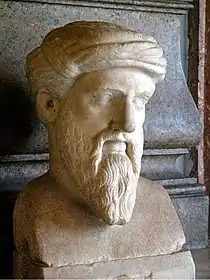
Although Socrates influenced Plato directly as related in the dialogues, the influence of Pythagoras upon Plato, or in a broader sense, the Pythagoreans, such as Archytas also appears to have been significant. Aristotle claimed that the philosophy of Plato closely followed the teachings of the Pythagoreans,[65] and Cicero repeats this claim: "They say Plato learned all things Pythagorean."[66] It is probable that both were influenced by Orphism, and both believed in metempsychosis, transmigration of the soul.
Pythagoras held that all things are number, and the cosmos comes from numerical principles. He introduced the concept of form as distinct from matter, and that the physical world is an imitation of an eternal mathematical world. These ideas were very influential on Heraclitus, Parmenides and Plato.[67]
George Karamanolis notes that
Numenius accepted both Pythagoras and Plato as the two authorities one should follow in philosophy, but he regarded Plato's authority as subordinate to that of Pythagoras, whom he considered to be the source of all true philosophy—including Plato's own. For Numenius it is just that Plato wrote so many philosophical works, whereas Pythagoras' views were originally passed on only orally.[68]
According to R. M. Hare, this influence consists of three points:
- The platonic Republic might be related to the idea of "a tightly organized community of like-minded thinkers", like the one established by Pythagoras in Croton.
- The idea that mathematics and, generally speaking, abstract thinking is a secure basis for philosophical thinking as well as "for substantial theses in science and morals".
- They shared a "mystical approach to the soul and its place in the material world".[69][70]
Plato and mathematics
Plato may have studied under the mathematician Theodorus of Cyrene, and has a dialogue named for and whose central character is the mathematician Theaetetus. While not a mathematician, Plato was considered an accomplished teacher of mathematics. Eudoxus of Cnidus, the greatest mathematician in Classical Greece, who contributed much of what is found in Euclid's Elements, was taught by Archytas and Plato. Plato helped to distinguish between pure and applied mathematics by widening the gap between "arithmetic", now called number theory and "logistic", now called arithmetic.[lower-alpha 8]
In the dialogue Timaeus Plato associated each of the four classical elements (earth, air, water, and fire) with a regular solid (cube, octahedron, icosahedron, and tetrahedron respectively) due to their shape, the so-called Platonic solids. The fifth regular solid, the dodecahedron, was supposed to be the element which made up the heavens.
Heraclitus and Parmenides
The two philosophers Heraclitus and Parmenides, following the way initiated by pre-Socratic Greek philosophers such as Pythagoras, depart from mythology and begin the metaphysical tradition that strongly influenced Plato and continues today.[67]
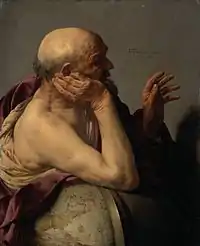
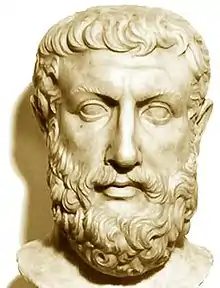
The surviving fragments written by Heraclitus suggest the view that all things are continuously changing, or becoming. His image of the river, with ever-changing waters, is well known. According to some ancient traditions such as that of Diogenes Laërtius, Plato received these ideas through Heraclitus' disciple Cratylus, who held the more radical view that continuous change warrants scepticism because we cannot define a thing that does not have a permanent nature.[72]
Parmenides adopted an altogether contrary vision, arguing for the idea of changeless Being and the view that change is an illusion.[67] John Palmer notes "Parmenides' distinction among the principal modes of being and his derivation of the attributes that must belong to what must be, simply as such, qualify him to be seen as the founder of metaphysics or ontology as a domain of inquiry distinct from theology."[73]
These ideas about change and permanence, or becoming and Being, influenced Plato in formulating his theory of Forms.[72]
Plato's most self-critical dialogue is the Parmenides, which features Parmenides and his student Zeno, who, following Parmenides' denial of change, argued forcefully through his paradoxes to deny the existence of motion.
Plato's Sophist dialogue includes an Eleatic stranger, a follower of Parmenides, as a foil for his arguments against Parmenides. In the dialogue, Plato distinguishes nouns and verbs, providing some of the earliest treatment of subject and predicate. He also argues that motion and rest both "are", against followers of Parmenides who say rest is but motion is not.
Socrates
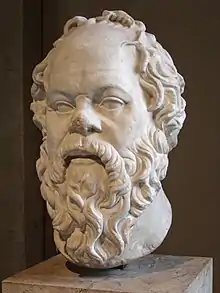
Plato was one of the devoted young followers of Socrates. The precise relationship between Plato and Socrates remains an area of contention among scholars.
Plato never speaks in his own voice in his dialogues; every dialogue except the Laws features Socrates, although many dialogues, including the Timaeus and Statesman, feature him speaking only rarely. In the Second Letter, it says, "no writing of Plato exists or ever will exist, but those now said to be his are those of a Socrates become beautiful and new";[74] if the letter is Plato's, the final qualification seems to call into question the dialogues' historical fidelity. In any case, Xenophon's Memorabilia and Aristophanes's The Clouds seem to present a somewhat different portrait of Socrates from the one Plato paints. The Socratic problem concerns how to reconcile these various accounts. Leo Strauss notes that Socrates' reputation for irony casts doubt on whether Plato's Socrates is expressing sincere beliefs.[75]
Aristotle attributes a different doctrine with respect to Forms to Plato and Socrates.[76] Aristotle suggests that Socrates' idea of forms can be discovered through investigation of the natural world, unlike Plato's Forms that exist beyond and outside the ordinary range of human understanding. In the dialogues of Plato though, Socrates sometimes seems to support a mystical side, discussing reincarnation and the mystery religions, this is generally attributed to Plato.[77] Regardless, this view of Socrates cannot be dismissed out of hand, as we cannot be sure of the differences between the views of Plato and Socrates. In the Meno, Plato refers to the Eleusinian Mysteries, telling Meno he would understand Socrates's answers better if he could stay for the initiations next week. It is possible that Plato and Socrates took part in the Eleusinian Mysteries.[78]
Philosophy
Metaphysics
In Plato's dialogues, Socrates and his company of disputants had something to say on many subjects, including several aspects of metaphysics. These include religion and science, human nature, love, and sexuality. More than one dialogue contrasts perception and reality, nature and custom, and body and soul. Francis Cornford referred to the "twin pillars of Platonism" as being the theory of Forms on the one hand, and, on the other hand, the doctrine of immortality of the soul.[79]
The Forms

"Platonism" and its theory of Forms (or theory of Ideas) denies the reality of the material world, considering it only an image or copy of the real world. The theory of Forms is first introduced in the Phaedo dialogue (also known as On the Soul), wherein Socrates refutes the pluralism of the likes of Anaxagoras, then the most popular response to Heraclitus and Parmenides, while giving the "Opposites Argument" in support of the Forms.
According to this theory of Forms, there are at least two worlds: the apparent world of concrete objects, grasped by the senses, which constantly changes, and an unchanging and unseen world of Forms or abstract objects, grasped by pure reason (λογική), which ground what is apparent.
It can also be said there are three worlds, with the apparent world consisting of both the world of material objects and of mental images, with the "third realm" consisting of the Forms. Thus, though there is the term "Platonic idealism", this refers to Platonic Ideas or the Forms, and not to some platonic kind of idealism, an 18th-century view which sees matter as unreal in favour of mind. For Plato, though grasped by the mind, only the Forms are truly real.
Plato's Forms thus represent types of things, as well as properties, patterns, and relations, to which we refer as objects. Just as individual tables, chairs, and cars refer to objects in this world, 'tableness', 'chairness', and 'carness', as well as e. g. justice, truth, and beauty refer to objects in another world. One of Plato's most cited examples for the Forms were the truths of geometry, such as the Pythagorean theorem.
In other words, the Forms are universals given as a solution to the problem of universals, or the problem of "the One and the Many", e. g. how one predicate "red" can apply to many red objects. For Plato, this is because there is one abstract object or Form of red, redness itself, in which the several red things "participate". As Plato's solution is that universals are Forms and that Forms are real if anything is, Plato's philosophy is unambiguously called Platonic realism. According to Aristotle, Plato's best-known argument in support of the Forms was the "one over many" argument.[80]
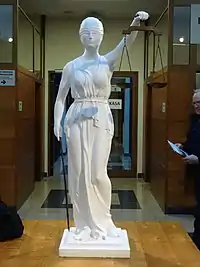
Aside from being immutable, timeless, changeless, and one over many, the Forms also provide definitions and the standard against which all instances are measured. In the dialogues Socrates regularly asks for the meaning – in the sense of intensional definitions – of a general term (e. g. justice, truth, beauty), and criticizes those who instead give him particular, extensional examples, rather than the quality shared by all examples.
There is thus a world of perfect, eternal, and changeless meanings of predicates, the Forms, existing in the realm of Being outside of space and time; and the imperfect sensible world of becoming, subjects somehow in a state between being and nothing, that partakes of the qualities of the Forms, and is its instantiation.
The soul
For Plato, as was characteristic of ancient Greek philosophy, the soul was that which gave life. See this brief exchange from the Phaedo: "What is it that, when present in a body, makes it living? — A soul."[81]
Another hallmark of Plato's view of the soul is that it is what rules and controls a person's body.[82] Plato uses this observation in the Alcibiades as evidence that people are their souls.
Plato advocates a belief in the immortality of the soul, and several dialogues end with long speeches imagining the afterlife. In the Timaeus, Socrates locates the parts of the soul within the human body: Reason is located in the head, spirit in the top third of the torso, and the appetite in the middle third of the torso, down to the navel.[83][84]
Furthermore, Plato evinces in multiple dialogues (such as the Phaedo and Timaeus) a belief in the theory of reincarnation. Scholars debate whether he intends the theory to be literally true, however.[85]
Epistemology
Plato also discusses several aspects of epistemology. More than one dialogue contrasts knowledge (episteme) and opinion (doxa). Plato's epistemology involves Socrates (and other characters, such as Timaeus) arguing that knowledge is not empirical, and that it comes from divine insight. The Forms are also responsible for both knowledge or certainty, and are grasped by pure reason.
In several dialogues, Socrates inverts the common man's intuition about what is knowable and what is real. Reality is unavailable to those who use their senses. Socrates says that he who sees with his eyes is blind. While most people take the objects of their senses to be real if anything is, Socrates is contemptuous of people who think that something has to be graspable in the hands to be real. In the Theaetetus, he says such people are eu amousoi (εὖ ἄμουσοι), an expression that means literally, "happily without the muses".[86] In other words, such people are willingly ignorant, living without divine inspiration and access to higher insights about reality.
In Plato's dialogues, Socrates always insists on his ignorance and humility, that he knows nothing, so-called "Socratic irony." Several dialogues refute a series of viewpoints, but offer no positive position, thus ending in aporia.
Recollection
In several of Plato's dialogues, Socrates promulgates the idea that knowledge is a matter of recollection of things acquainted with before one is born, and not of observation or study.[87] Keeping with the theme of admitting his own ignorance, Socrates regularly complains of his forgetfulness. In the Meno, Socrates uses a geometrical example to expound Plato's view that knowledge in this latter sense is acquired by recollection. Socrates elicits a fact concerning a geometrical construction from a slave boy, who could not have otherwise known the fact (due to the slave boy's lack of education). The knowledge must be present, Socrates concludes, in an eternal, non-experiential form.
In other dialogues, the Sophist, Statesman, Republic, and the Parmenides, Plato himself associates knowledge with the apprehension of unchanging Forms and their relationships to one another (which he calls "expertise" in dialectic), including through the processes of collection and division.[88] More explicitly, Plato himself argues in the Timaeus that knowledge is always proportionate to the realm from which it is gained. In other words, if one derives one's account of something experientially, because the world of sense is in flux, the views therein attained will be mere opinions. Meanwhile, opinions are characterized by a lack of necessity and stability. On the other hand, if one derives one's account of something by way of the non-sensible forms, because these forms are unchanging, so too is the account derived from them. That apprehension of forms is required for knowledge may be taken to cohere with Plato's theory in the Theaetetus and Meno.[89] Indeed, the apprehension of Forms may be at the base of the "account" required for justification, in that it offers foundational knowledge which itself needs no account, thereby avoiding an infinite regression.[90]
Justified true belief
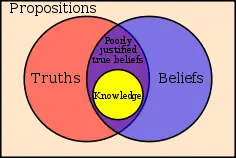
Many have interpreted Plato as stating — even having been the first to write — that knowledge is justified true belief, an influential view that informed future developments in epistemology.[91] This interpretation is partly based on a reading of the Theaetetus wherein Plato argues that knowledge is distinguished from mere true belief by the knower having an "account" of the object of their true belief.[92] And this theory may again be seen in the Meno, where it is suggested that true belief can be raised to the level of knowledge if it is bound with an account as to the question of "why" the object of the true belief is so.[93][94]
Many years later, Edmund Gettier famously demonstrated the problems of the justified true belief account of knowledge. That the modern theory of justified true belief as knowledge, which Gettier addresses, is equivalent to Plato's is accepted by some scholars but rejected by others.[95] Plato himself also identified problems with the justified true belief definition in the Theaetetus, concluding that justification (or an "account") would require knowledge of difference, meaning that the definition of knowledge is circular.[96][97]
Ethics
Several dialogues discuss ethics including virtue and vice, pleasure and pain, crime and punishment, and justice and medicine. Plato views "The Good" as the supreme Form, somehow existing even "beyond being".
Socrates propounded a moral intellectualism which claimed nobody does bad on purpose, and to know what is good results in doing what is good; that knowledge is virtue. In the Protagoras dialogue it is argued that virtue is innate and cannot be learned.
Socrates presents the famous Euthyphro dilemma in the dialogue of the same name: "Is the pious (τὸ ὅσιον) loved by the gods because it is pious, or is it pious because it is loved by the gods?" (10a)
Justice
As above, in the Republic, Plato asks the question, “What is justice?” By means of the Greek term dikaiosune – a term for “justice” that captures both individual justice and the justice that informs societies, Plato is able not only to inform metaphysics, but also ethics and politics with the question: “What is the basis of moral and social obligation?” Plato's well-known answer rests upon the fundamental responsibility to seek wisdom, wisdom which leads to an understanding of the Form of the Good. Plato further argues that such understanding of Forms produces and ensures the good communal life when ideally structured under a philosopher king in a society with three classes (philosopher kings, guardians, and workers) that neatly mirror his triadic view of the individual soul (reason, spirit, and appetite). In this manner, justice is obtained when knowledge of how to fulfill one's moral and political function in society is put into practice.[98]
Politics
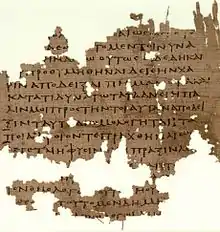
The dialogues also discuss politics. Some of Plato's most famous doctrines are contained in the Republic as well as in the Laws and the Statesman. Because these opinions are not spoken directly by Plato and vary between dialogues, they cannot be straightforwardly assumed as representing Plato's own views.
Socrates asserts that societies have a tripartite class structure corresponding to the appetite/spirit/reason structure of the individual soul. The appetite/spirit/reason are analogous to the castes of society.[99]
- Productive (Workers) – the labourers, carpenters, plumbers, masons, merchants, farmers, ranchers, etc. These correspond to the "appetite" part of the soul.
- Protective (Warriors or Guardians) – those who are adventurous, strong and brave; in the armed forces. These correspond to the "spirit" part of the soul.
- Governing (Rulers or Philosopher Kings) – those who are intelligent, rational, self-controlled, in love with wisdom, well suited to make decisions for the community. These correspond to the "reason" part of the soul and are very few.
According to this model, the principles of Athenian democracy (as it existed in his day) are rejected as only a few are fit to rule. Instead of rhetoric and persuasion, Socrates says reason and wisdom should govern. As Socrates puts it:
- "Until philosophers rule as kings or those who are now called kings and leading men genuinely and adequately philosophize, that is, until political power and philosophy entirely coincide, while the many natures who at present pursue either one exclusively are forcibly prevented from doing so, cities will have no rest from evils,... nor, I think, will the human race."[100]
Socrates describes these "philosopher kings" as "those who love the sight of truth"[101] and supports the idea with the analogy of a captain and his ship or a doctor and his medicine. According to him, sailing and health are not things that everyone is qualified to practice by nature. A large part of the Republic then addresses how the educational system should be set up to produce these philosopher kings.
In addition, the ideal city is used as an image to illuminate the state of one's soul, or the will, reason, and desires combined in the human body. Socrates is attempting to make an image of a rightly ordered human, and then later goes on to describe the different kinds of humans that can be observed, from tyrants to lovers of money in various kinds of cities. The ideal city is not promoted, but only used to magnify the different kinds of individual humans and the state of their soul. However, the philosopher king image was used by many after Plato to justify their personal political beliefs. The philosophic soul according to Socrates has reason, will, and desires united in virtuous harmony. A philosopher has the moderate love for wisdom and the courage to act according to wisdom. Wisdom is knowledge about the Good or the right relations between all that exists.
Wherein it concerns states and rulers, Socrates asks which is better—a bad democracy or a country reigned by a tyrant. He argues that it is better to be ruled by a bad tyrant, than by a bad democracy (since here all the people are now responsible for such actions, rather than one individual committing many bad deeds.) This is emphasised within the Republic as Socrates describes the event of mutiny on board a ship.[102] Socrates suggests the ship's crew to be in line with the democratic rule of many and the captain, although inhibited through ailments, the tyrant. Socrates' description of this event is parallel to that of democracy within the state and the inherent problems that arise.
According to Socrates, a state made up of different kinds of souls will, overall, decline from an aristocracy (rule by the best) to a timocracy (rule by the honourable), then to an oligarchy (rule by the few), then to a democracy (rule by the people), and finally to tyranny (rule by one person, rule by a tyrant).[103] Aristocracy in the sense of government (politeia) is advocated in Plato's Republic. This regime is ruled by a philosopher king, and thus is grounded on wisdom and reason.
The aristocratic state, and the man whose nature corresponds to it, are the objects of Plato's analyses throughout much of the Republic, as opposed to the other four types of states/men, who are discussed later in his work. In Book VIII, Socrates states in order the other four imperfect societies with a description of the state's structure and individual character. In timocracy, the ruling class is made up primarily of those with a warrior-like character.[104] Oligarchy is made up of a society in which wealth is the criterion of merit and the wealthy are in control.[105] In democracy, the state bears resemblance to ancient Athens with traits such as equality of political opportunity and freedom for the individual to do as he likes.[106] Democracy then degenerates into tyranny from the conflict of rich and poor. It is characterized by an undisciplined society existing in chaos, where the tyrant rises as a popular champion leading to the formation of his private army and the growth of oppression.[107][103][108]
Art and poetry
Several dialogues tackle questions about art, including rhetoric and rhapsody. Socrates says that poetry is inspired by the muses, and is not rational. He speaks approvingly of this, and other forms of divine madness (drunkenness, eroticism, and dreaming) in the Phaedrus,[109] and yet in the Republic wants to outlaw Homer's great poetry, and laughter as well. In Ion, Socrates gives no hint of the disapproval of Homer that he expresses in the Republic. The dialogue Ion suggests that Homer's Iliad functioned in the ancient Greek world as the Bible does today in the modern Christian world: as divinely inspired literature that can provide moral guidance, if only it can be properly interpreted.
Rhetoric
Scholars often view Plato's philosophy as at odds with rhetoric due to his criticisms of rhetoric in the Gorgias and his ambivalence toward rhetoric expressed in the Phaedrus. But other contemporary researchers contest the idea that Plato despised rhetoric and instead view his dialogues as a dramatization of complex rhetorical principles.[110][111][112]
Unwritten doctrines
For a long time, Plato's unwritten doctrines[113][114][115] had been controversial. Many modern books on Plato seem to diminish its importance; nevertheless, the first important witness who mentions its existence is Aristotle, who in his Physics writes: "It is true, indeed, that the account he gives there [i.e. in Timaeus] of the participant is different from what he says in his so-called unwritten teachings (Ancient Greek: ἄγραφα δόγματα, romanized: agrapha dogmata)."[116] The term "ἄγραφα δόγματα" literally means unwritten doctrines or unwritten dogmas and it stands for the most fundamental metaphysical teaching of Plato, which he disclosed only orally, and some say only to his most trusted fellows, and which he may have kept secret from the public. The importance of the unwritten doctrines does not seem to have been seriously questioned before the 19th century.
A reason for not revealing it to everyone is partially discussed in Phaedrus where Plato criticizes the written transmission of knowledge as faulty, favouring instead the spoken logos: "he who has knowledge of the just and the good and beautiful ... will not, when in earnest, write them in ink, sowing them through a pen with words, which cannot defend themselves by argument and cannot teach the truth effectually."[117] The same argument is repeated in Plato's Seventh Letter: "every serious man in dealing with really serious subjects carefully avoids writing."[118] In the same letter he writes: "I can certainly declare concerning all these writers who claim to know the subjects that I seriously study ... there does not exist, nor will there ever exist, any treatise of mine dealing therewith."[119] Such secrecy is necessary in order not "to expose them to unseemly and degrading treatment".[120]
It is, however, said that Plato once disclosed this knowledge to the public in his lecture On the Good (Περὶ τἀγαθοῦ), in which the Good (τὸ ἀγαθόν) is identified with the One (the Unity, τὸ ἕν), the fundamental ontological principle. The content of this lecture has been transmitted by several witnesses. Aristoxenus describes the event in the following words: "Each came expecting to learn something about the things that are generally considered good for men, such as wealth, good health, physical strength, and altogether a kind of wonderful happiness. But when the mathematical demonstrations came, including numbers, geometrical figures and astronomy, and finally the statement Good is One seemed to them, I imagine, utterly unexpected and strange; hence some belittled the matter, while others rejected it."[121] Simplicius quotes Alexander of Aphrodisias, who states that "according to Plato, the first principles of everything, including the Forms themselves are One and Indefinite Duality (ἡ ἀόριστος δυάς), which he called Large and Small (τὸ μέγα καὶ τὸ μικρόν)", and Simplicius reports as well that "one might also learn this from Speusippus and Xenocrates and the others who were present at Plato's lecture on the Good".[45]
Their account is in full agreement with Aristotle's description of Plato's metaphysical doctrine. In Metaphysics he writes: "Now since the Forms are the causes of everything else, he [i.e. Plato] supposed that their elements are the elements of all things. Accordingly, the material principle is the Great and Small [i.e. the Dyad], and the essence is the One (τὸ ἕν), since the numbers are derived from the Great and Small by participation in the One".[122] "From this account it is clear that he only employed two causes: that of the essence, and the material cause; for the Forms are the cause of the essence in everything else, and the One is the cause of it in the Forms. He also tells us what the material substrate is of which the Forms are predicated in the case of sensible things, and the One in that of the Forms—that it is this the duality (the Dyad, ἡ δυάς), the Great and Small (τὸ μέγα καὶ τὸ μικρόν). Further, he assigned to these two elements respectively the causation of good and of evil".[122]
The most important aspect of this interpretation of Plato's metaphysics is the continuity between his teaching and the Neoplatonic interpretation of Plotinus[lower-alpha 9] or Ficino[lower-alpha 10] which has been considered erroneous by many but may in fact have been directly influenced by oral transmission of Plato's doctrine. A modern scholar who recognized the importance of the unwritten doctrine of Plato was Heinrich Gomperz who described it in his speech during the 7th International Congress of Philosophy in 1930.[123] All the sources related to the ἄγραφα δόγματα have been collected by Konrad Gaiser and published as Testimonia Platonica.[124] These sources have subsequently been interpreted by scholars from the German Tübingen School of interpretation such as Hans Joachim Krämer or Thomas A. Szlezák.[lower-alpha 11]
Themes of Plato's dialogues
Trial of Socrates

The trial of Socrates and his death sentence is the central, unifying event of Plato's dialogues. It is relayed in the dialogues Apology, Crito, and Phaedo. Apology is Socrates' defence speech, and Crito and Phaedo take place in prison after the conviction.
Apology is among the most frequently read of Plato's works. In the Apology, Socrates tries to dismiss rumours that he is a sophist and defends himself against charges of disbelief in the gods and corruption of the young. Socrates insists that long-standing slander will be the real cause of his demise, and says the legal charges are essentially false. Socrates famously denies being wise, and explains how his life as a philosopher was launched by the Oracle at Delphi. He says that his quest to resolve the riddle of the oracle put him at odds with his fellow man, and that this is the reason he has been mistaken for a menace to the city-state of Athens.
In Apology, Socrates is presented as mentioning Plato by name as one of those youths close enough to him to have been corrupted, if he were in fact guilty of corrupting the youth, and questioning why their fathers and brothers did not step forward to testify against him if he was indeed guilty of such a crime.[125] Later, Plato is mentioned along with Crito, Critobolus, and Apollodorus as offering to pay a fine of 30 minas on Socrates' behalf, in lieu of the death penalty proposed by Meletus.[126] In the Phaedo, the title character lists those who were in attendance at the prison on Socrates' last day, explaining Plato's absence by saying, "Plato was ill".[127]
The trial in other dialogues
If Plato's important dialogues do not refer to Socrates' execution explicitly, they allude to it, or use characters or themes that play a part in it. Five dialogues foreshadow the trial: In the Theaetetus and the Euthyphro Socrates tells people that he is about to face corruption charges.[128][129] In the Meno, one of the men who brings legal charges against Socrates, Anytus, warns him about the trouble he may get into if he does not stop criticizing important people.[130] In the Gorgias, Socrates says that his trial will be like a doctor prosecuted by a cook who asks a jury of children to choose between the doctor's bitter medicine and the cook's tasty treats.[131] In the Republic, Socrates explains why an enlightened man (presumably himself) will stumble in a courtroom situation.[132] Plato's support of aristocracy and distrust of democracy is also taken to be partly rooted in a democracy having killed Socrates. In the Protagoras, Socrates is a guest at the home of Callias, son of Hipponicus, a man whom Socrates disparages in the Apology as having wasted a great amount of money on sophists' fees.
Two other important dialogues, the Symposium and the Phaedrus, are linked to the main storyline by characters. In the Apology, Socrates says Aristophanes slandered him in a comic play, and blames him for causing his bad reputation, and ultimately, his death.[133] In the Symposium, the two of them are drinking together with other friends. The character Phaedrus is linked to the main story line by character (Phaedrus is also a participant in the Symposium and the Protagoras) and by theme (the philosopher as divine emissary, etc.) The Protagoras is also strongly linked to the Symposium by characters: all of the formal speakers at the Symposium (with the exception of Aristophanes) are present at the home of Callias in that dialogue. Charmides and his guardian Critias are present for the discussion in the Protagoras. Examples of characters crossing between dialogues can be further multiplied. The Protagoras contains the largest gathering of Socratic associates.
In the dialogues Plato is most celebrated and admired for, Socrates is concerned with human and political virtue, has a distinctive personality, and friends and enemies who "travel" with him from dialogue to dialogue. This is not to say that Socrates is consistent: a man who is his friend in one dialogue may be an adversary or subject of his mockery in another. For example, Socrates praises the wisdom of Euthyphro many times in the Cratylus, but makes him look like a fool in the Euthyphro. He disparages sophists generally, and Prodicus specifically in the Apology, whom he also slyly jabs in the Cratylus for charging the hefty fee of fifty drachmas for a course on language and grammar. However, Socrates tells Theaetetus in his namesake dialogue that he admires Prodicus and has directed many pupils to him. Socrates' ideas are also not consistent within or between or among dialogues.
Allegories
Mythos and logos are terms that evolved throughout classical Greek history. In the times of Homer and Hesiod (i.e., the 8th century BC) they were essentially synonyms, and contained the meaning of 'tale' or 'history'. Later came historians like Herodotus and Thucydides, as well as philosophers like Heraclitus and Parmenides and other Presocratics who introduced a distinction between both terms; mythos became more a nonverifiable account, and logos a rational account.[134] It may seem that Plato, being a disciple of Socrates and a strong partisan of philosophy based on logos, should have avoided the use of myth-telling. Instead, he made abundant use of it. This fact has produced analytical and interpretative work, in order to clarify the reasons and purposes for that use. Furthermore, Plato himself often oscillates between calling one and the same thing a muthos and a logos, revealing a preference for the earlier view that the two terms are synonyms.[135]
Plato, in general, distinguished between three types of myth.[lower-alpha 12] First, there were the false myths, like those based on stories of gods subject to passions and sufferings, because reason teaches that God is perfect. Then came the myths based on true reasoning, and therefore also true. Finally, there were those non-verifiable because beyond of human reason, but containing some truth in them. Regarding the subjects of Plato's myths, they are of two types, those dealing with the origin of the universe, and those about morals and the origin and fate of the soul.[136]
It is generally agreed that the main purpose for Plato in using myths was didactic.[137] He considered that only a few people were capable or interested in following a reasoned philosophical discourse, but men in general are attracted by stories and tales. Consequently, then, he used the myth to convey the conclusions of the philosophical reasoning. Some of Plato's myths were based in traditional ones, others were modifications of them, and finally, he also invented altogether new myths.[138] Notable examples include the story of Atlantis, the Myth of Er, and the Allegory of the Cave.
The Cave
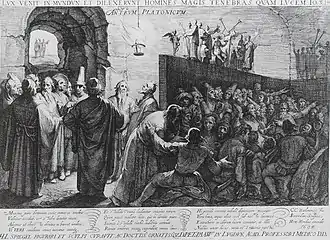
The theory of Forms is most famously captured in his Allegory of the Cave, and more explicitly in his analogy of the sun and the divided line. The Allegory of the Cave is a paradoxical analogy wherein Socrates argues that the invisible world is the most intelligible (noeton) and that the visible world ((h)oraton) is the least knowable, and the most obscure.
Socrates says in the Republic that people who take the sun-lit world of the senses to be good and real are living pitifully in a den of evil and ignorance. Socrates admits that few climb out of the den, or cave of ignorance, and those who do, not only have a terrible struggle to attain the heights, but when they go back down for a visit or to help other people up, they find themselves objects of scorn and ridicule.
According to Socrates, physical objects and physical events are "shadows" of their ideal or perfect forms, and exist only to the extent that they instantiate the perfect versions of themselves. Just as shadows are temporary, inconsequential epiphenomena produced by physical objects, physical objects are themselves fleeting phenomena caused by more substantial causes, the ideals of which they are mere instances. For example, Socrates thinks that perfect justice exists (although it is not clear where) and his own trial would be a cheap copy of it.
The Allegory of the Cave is intimately connected to his political ideology, that only people who have climbed out of the cave and cast their eyes on a vision of goodness are fit to rule. Socrates claims that the enlightened men of society must be forced from their divine contemplation and be compelled to run the city according to their lofty insights. Thus is born the idea of the "philosopher-king", the wise person who accepts the power thrust upon him by the people who are wise enough to choose a good master. This is the main thesis of Socrates in the Republic, that the most wisdom the masses can muster is the wise choice of a ruler.[139]
Ring of Gyges
A ring which could make one invisible, the Ring of Gyges is proposed in the Republic by the character of Glaucon, and considered by the rest of the characters for its ethical consequences, whether an individual possessing it would be most happy abstaining or doing injustice.
Chariot
He also compares the soul (psyche) to a chariot. In this allegory he introduces a triple soul composed of a charioteer and two horses. The charioteer is a symbol of the intellectual and logical part of the soul (logistikon), and the two horses represent the moral virtues (thymoeides) and passionate instincts (epithymetikon), respectively, to illustrate the conflict between them.
Dialectic
Socrates employs a dialectic method which proceeds by questioning. The role of dialectic in Plato's thought is contested but there are two main interpretations: a type of reasoning and a method of intuition.[140] Simon Blackburn adopts the first, saying that Plato's dialectic is "the process of eliciting the truth by means of questions aimed at opening out what is already implicitly known, or at exposing the contradictions and muddles of an opponent's position."[140] A similar interpretation has been put forth by Louis Hartz, who compares Plato's dialectic to that of Hegel.[141] According to this view, opposing arguments improve upon each other, and prevailing opinion is shaped by the synthesis of many conflicting ideas over time. Each new idea exposes a flaw in the accepted model, and the epistemological substance of the debate continually approaches the truth. Hartz's is a teleological interpretation at the core, in which philosophers will ultimately exhaust the available body of knowledge and thus reach "the end of history." Karl Popper, on the other hand, claims that dialectic is the art of intuition for "visualising the divine originals, the Forms or Ideas, of unveiling the Great Mystery behind the common man's everyday world of appearances."[142]
Family
Plato often discusses the father-son relationship and the question of whether a father's interest in his sons has much to do with how well his sons turn out. In ancient Athens, a boy was socially located by his family identity, and Plato often refers to his characters in terms of their paternal and fraternal relationships. Socrates was not a family man, and saw himself as the son of his mother, who was apparently a midwife. A divine fatalist, Socrates mocks men who spent exorbitant fees on tutors and trainers for their sons, and repeatedly ventures the idea that good character is a gift from the gods. Plato's dialogue Crito reminds Socrates that orphans are at the mercy of chance, but Socrates is unconcerned. In the Theaetetus, he is found recruiting as a disciple a young man whose inheritance has been squandered. Socrates twice compares the relationship of the older man and his boy lover to the father-son relationship,[143][144] and in the Phaedo, Socrates' disciples, towards whom he displays more concern than his biological sons, say they will feel "fatherless" when he is gone.
Though Plato agreed with Aristotle that women were inferior to men, in the fourth book of the Republic the character of Socrates says this was only because of nomos or custom and not because of nature, and thus women needed paidia, rearing or education to be equal to men. In the "merely probable tale" of the eponymous character in the Timaeus, unjust men who live corrupted lives would be reincarnated as women or various animal kinds.
Narration
Plato never presents himself as a participant in any of the dialogues, and with the exception of the Apology, there is no suggestion that he heard any of the dialogues firsthand. Some dialogues have no narrator but have a pure "dramatic" form (examples: Meno, Gorgias, Phaedrus, Crito, Euthyphro), some dialogues are narrated by Socrates, wherein he speaks in first person (examples: Lysis, Charmides, Republic). One dialogue, Protagoras, begins in dramatic form but quickly proceeds to Socrates' narration of a conversation he had previously with the sophist for whom the dialogue is named; this narration continues uninterrupted till the dialogue's end.
_-_Google_Art_Project.jpg.webp)
Two dialogues Phaedo and Symposium also begin in dramatic form but then proceed to virtually uninterrupted narration by followers of Socrates. Phaedo, an account of Socrates' final conversation and hemlock drinking, is narrated by Phaedo to Echecrates in a foreign city not long after the execution took place.[lower-alpha 13] The Symposium is narrated by Apollodorus, a Socratic disciple, apparently to Glaucon. Apollodorus assures his listener that he is recounting the story, which took place when he himself was an infant, not from his own memory, but as remembered by Aristodemus, who told him the story years ago.
The Theaetetus is a peculiar case: a dialogue in dramatic form embedded within another dialogue in dramatic form. In the beginning of the Theaetetus,[146] Euclides says that he compiled the conversation from notes he took based on what Socrates told him of his conversation with the title character. The rest of the Theaetetus is presented as a "book" written in dramatic form and read by one of Euclides' slaves.[147] Some scholars take this as an indication that Plato had by this date wearied of the narrated form.[148] With the exception of the Theaetetus, Plato gives no explicit indication as to how these orally transmitted conversations came to be written down.
History of Plato's dialogues
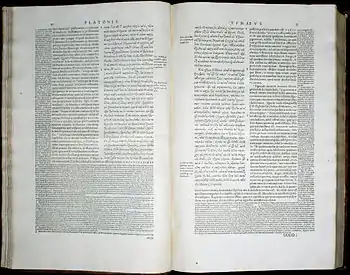
Thirty-five dialogues and thirteen letters (the Epistles) have traditionally been ascribed to Plato, though modern scholarship doubts the authenticity of at least some of these. Plato's writings have been published in several fashions; this has led to several conventions regarding the naming and referencing of Plato's texts.
The usual system for making unique references to sections of the text by Plato derives from a 16th-century edition of Plato's works by Henricus Stephanus known as Stephanus pagination.
One tradition regarding the arrangement of Plato's texts is according to tetralogies. This scheme is ascribed by Diogenes Laërtius to an ancient scholar and court astrologer to Tiberius named Thrasyllus. The list includes works of doubtful authenticity (written in italic), and includes the Letters.
- 1st tetralogy
- 2nd tetralogy
- Cratylus, Theatetus, Sophist, Statesman
- 3nd tetralogy
- 4th tetralogy
- Alcibiades I, Alcibiades II, Hipparchus, Lovers
- 5th tetralogy
- Theages, Charmides, Laches, Lysis
- 6th tetralogy
- Euthydemus, Protagoras, Gorgias, Meno
- 7th tetralogy
- Hippias Major, Hippias Minor, Ion, Menexenus
- 8th tetralogy
- Clitophon, Republic, Timaeus, Critias
- 9th tetralogy
- Minos, Laws, Epinomis, Letters
Chronology
No one knows the exact order Plato's dialogues were written in, nor the extent to which some might have been later revised and rewritten. The works are usually grouped into Early (sometimes by some into Transitional), Middle, and Late period.[149][150] This choice to group chronologically is thought worthy of criticism by some (Cooper et al),[151] given that it is recognized that there is no absolute agreement as to the true chronology, since the facts of the temporal order of writing are not confidently ascertained.[152] Chronology was not a consideration in ancient times, in that groupings of this nature are virtually absent (Tarrant) in the extant writings of ancient Platonists.[153]
Whereas those classified as "early dialogues" often conclude in aporia, the so-called "middle dialogues" provide more clearly stated positive teachings that are often ascribed to Plato such as the theory of Forms. The remaining dialogues are classified as "late" and are generally agreed to be difficult and challenging pieces of philosophy. This grouping is the only one proven by stylometric analysis.[154] Among those who classify the dialogues into periods of composition, Socrates figures in all of the "early dialogues" and they are considered the most faithful representations of the historical Socrates.[155]
The following represents one relatively common division.[156] It should, however, be kept in mind that many of the positions in the ordering are still highly disputed, and also that the very notion that Plato's dialogues can or should be "ordered" is by no means universally accepted. Increasingly in the most recent Plato scholarship, writers are sceptical of the notion that the order of Plato's writings can be established with any precision,[157] though Plato's works are still often characterized as falling at least roughly into three groups.[7]
Early: Apology, Charmides, Crito, Euthyphro, Gorgias, Hippias Minor, Hippias Major, Ion, Laches, Lysis, Protagoras
Middle: Cratylus, Euthydemus, Meno, Parmenides, Phaedo, Phaedrus, Republic, Symposium, Theatetus
Late: Critias, Sophist, Statesman, Timaeus, Philebus, Laws.[155]
A significant distinction of the early Plato and the later Plato has been offered by scholars such as E.R. Dodds and has been summarized by Harold Bloom in his book titled Agon: "E.R. Dodds is the classical scholar whose writings most illuminated the Hellenic descent (in) The Greeks and the Irrational ... In his chapter on Plato and the Irrational Soul ... Dodds traces Plato's spiritual evolution from the pure rationalist of the Protagoras to the transcendental psychologist, influenced by the Pythagoreans and Orphics, of the later works culminating in the Laws."[158]
Lewis Campbell was the first[159] to make exhaustive use of stylometry to prove the great probability that the Critias, Timaeus, Laws, Philebus, Sophist, and Statesman were all clustered together as a group, while the Parmenides, Phaedrus, Republic, and Theaetetus belong to a separate group, which must be earlier (given Aristotle's statement in his Politics[160] that the Laws was written after the Republic; cf. Diogenes Laërtius Lives 3.37). What is remarkable about Campbell's conclusions is that, in spite of all the stylometric studies that have been conducted since his time, perhaps the only chronological fact about Plato's works that can now be said to be proven by stylometry is the fact that Critias, Timaeus, Laws, Philebus, Sophist, and Statesman are the latest of Plato's dialogues, the others earlier.[154]
Protagoras is often considered one of the last of the "early dialogues". Three dialogues are often considered "transitional" or "pre-middle": Euthydemus, Gorgias, and Meno. Proponents of dividing the dialogues into periods often consider the Parmenides and Theaetetus to come late in the middle period and be transitional to the next, as they seem to treat the theory of Forms critically (Parmenides) or only indirectly (Theaetetus).[161] Ritter's stylometric analysis places Phaedrus as probably after Theaetetus and Parmenides,[162] although it does not relate to the theory of Forms in the same way. The first book of the Republic is often thought to have been written significantly earlier than the rest of the work, although possibly having undergone revisions when the later books were attached to it.[161]
While looked to for Plato's "mature" answers to the questions posed by his earlier works, those answers are difficult to discern. Some scholars[155] indicate that the theory of Forms is absent from the late dialogues, its having been refuted in the Parmenides, but there is not total consensus that the Parmenides actually refutes the theory of Forms.[163]
Writings of doubted authenticity
Jowett mentions in his Appendix to Menexenus, that works which bore the character of a writer were attributed to that writer even when the actual author was unknown.[164]
For below:
(*) if there is no consensus among scholars as to whether Plato is the author, and (‡) if most scholars agree that Plato is not the author of the work.[165]
Alcibiades I (*), Alcibiades II (‡), Clitophon (*), Epinomis (‡), Letters (*), Hipparchus (‡), Menexenus (*), Minos (‡), Lovers (‡), Theages (‡)
Spurious writings
The following works were transmitted under Plato's name, most of them already considered spurious in antiquity, and so were not included by Thrasyllus in his tetralogical arrangement. These works are labelled as Notheuomenoi ("spurious") or Apocrypha.
Axiochus, Definitions, Demodocus, Epigrams, Eryxias, Halcyon, On Justice, On Virtue, Sisyphus.
Textual sources and history

Some 250 known manuscripts of Plato survive.[166] The texts of Plato as received today apparently represent the complete written philosophical work of Plato and are generally good by the standards of textual criticism.[167] No modern edition of Plato in the original Greek represents a single source, but rather it is reconstructed from multiple sources which are compared with each other. These sources are medieval manuscripts written on vellum (mainly from 9th to 13th century AD Byzantium), papyri (mainly from late antiquity in Egypt), and from the independent testimonia of other authors who quote various segments of the works (which come from a variety of sources). The text as presented is usually not much different from what appears in the Byzantine manuscripts, and papyri and testimonia just confirm the manuscript tradition. In some editions, however, the readings in the papyri or testimonia are favoured in some places by the editing critic of the text. Reviewing editions of papyri for the Republic in 1987, Slings suggests that the use of papyri is hampered due to some poor editing practices.[168]
In the first century AD, Thrasyllus of Mendes had compiled and published the works of Plato in the original Greek, both genuine and spurious. While it has not survived to the present day, all the extant medieval Greek manuscripts are based on his edition.[169]
The oldest surviving complete manuscript for many of the dialogues is the Clarke Plato (Codex Oxoniensis Clarkianus 39, or Codex Boleianus MS E.D. Clarke 39), which was written in Constantinople in 895 and acquired by Oxford University in 1809.[170] The Clarke is given the siglum B in modern editions. B contains the first six tetralogies and is described internally as being written by "John the Calligrapher" on behalf of Arethas of Caesarea. It appears to have undergone corrections by Arethas himself.[171] For the last two tetralogies and the apocrypha, the oldest surviving complete manuscript is Codex Parisinus graecus 1807, designated A, which was written nearly contemporaneously to B, circa 900 AD.[172] A must be a copy of the edition edited by the patriarch, Photios, teacher of Arethas.[173][174][175]A probably had an initial volume containing the first 7 tetralogies which is now lost, but of which a copy was made, Codex Venetus append. class. 4, 1, which has the siglum T. The oldest manuscript for the seventh tetralogy is Codex Vindobonensis 54. suppl. phil. Gr. 7, with siglum W, with a supposed date in the twelfth century.[176] In total there are fifty-one such Byzantine manuscripts known, while others may yet be found.[177]
To help establish the text, the older evidence of papyri and the independent evidence of the testimony of commentators and other authors (i.e., those who quote and refer to an old text of Plato which is no longer extant) are also used. Many papyri which contain fragments of Plato's texts are among the Oxyrhynchus Papyri. The 2003 Oxford Classical Texts edition by Slings even cites the Coptic translation of a fragment of the Republic in the Nag Hammadi library as evidence.[178] Important authors for testimony include Olympiodorus the Younger, Plutarch, Proclus, Iamblichus, Eusebius, and Stobaeus.
During the early Renaissance, the Greek language and, along with it, Plato's texts were reintroduced to Western Europe by Byzantine scholars. In September or October 1484 Filippo Valori and Francesco Berlinghieri printed 1025 copies of Ficino's translation, using the printing press at the Dominican convent S.Jacopo di Ripoli.[179][180] Cosimo had been influenced toward studying Plato by the many Byzantine Platonists in Florence during his day, including George Gemistus Plethon.
The 1578 edition[181] of Plato's complete works published by Henricus Stephanus (Henri Estienne) in Geneva also included parallel Latin translation and running commentary by Joannes Serranus (Jean de Serres). It was this edition which established standard Stephanus pagination, still in use today.[182]
Modern editions
The Oxford Classical Texts offers the current standard complete Greek text of Plato's complete works. In five volumes edited by John Burnet, its first edition was published 1900–1907, and it is still available from the publisher, having last been printed in 1993.[183][184] The second edition is still in progress with only the first volume, printed in 1995, and the Republic, printed in 2003, available. The Cambridge Greek and Latin Texts and Cambridge Classical Texts and Commentaries series includes Greek editions of the Protagoras, Symposium, Phaedrus, Alcibiades, and Clitophon, with English philological, literary, and, to an extent, philosophical commentary.[185][186] One distinguished edition of the Greek text is E. R. Dodds' of the Gorgias, which includes extensive English commentary.[187][188]
The modern standard complete English edition is the 1997 Hackett Plato, Complete Works, edited by John M. Cooper.[189][190] For many of these translations Hackett offers separate volumes which include more by way of commentary, notes, and introductory material. There is also the Clarendon Plato Series by Oxford University Press which offers English translations and thorough philosophical commentary by leading scholars on a few of Plato's works, including John McDowell's version of the Theaetetus.[191] Cornell University Press has also begun the Agora series of English translations of classical and medieval philosophical texts, including a few of Plato's.[192]
Criticism
The most famous criticism of the Theory of Forms is the Third Man Argument by Aristotle in the Metaphysics. Plato had actually already considered this objection with the idea of "large" rather than "man," in the dialogue Parmenides, using the elderly Elean philosophers Parmenides and Zeno characters anachronistically to criticize the character of the younger Socrates who proposed it. The dialogue ends in aporia.
Many recent philosophers have diverged from what some would describe as the ontological models and moral ideals characteristic of traditional Platonism. A number of these postmodern philosophers have thus appeared to disparage Platonism from more or less informed perspectives. Friedrich Nietzsche notoriously attacked Plato's "idea of the good itself" along with many fundamentals of Christian morality, which he interpreted as "Platonism for the masses" in one of his most important works, Beyond Good and Evil (1886). Martin Heidegger argued against Plato's alleged obfuscation of Being in his incomplete tome, Being and Time (1927), and the philosopher of science Karl Popper argued in the first volume of The Open Society and Its Enemies (1945) that Plato's alleged proposal for a utopian political regime in the Republic was prototypically totalitarian.
Legacy
In the arts
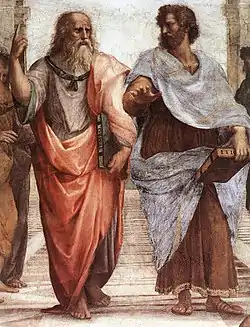
Plato's Academy mosaic was created in the villa of T. Siminius Stephanus in Pompeii, around 100 BC to 100 CE. The School of Athens fresco by Raphael features Plato also as a central figure. The Nuremberg Chronicle depicts Plato and others as anachronistic schoolmen.
In philosophy
Plato's thought is often compared with that of his most famous student, Aristotle, whose reputation during the Western Middle Ages so completely eclipsed that of Plato that the Scholastic philosophers referred to Aristotle as "the Philosopher". However, the study of Plato continued in the Byzantine Empire, the Caliphates during the Islamic Golden Age, and Spain during Golden age of Jewish culture.
The only Platonic work known to western scholarship was Timaeus, until translations were made after the fall of Constantinople, which occurred during 1453.[193] George Gemistos Plethon brought Plato's original writings from Constantinople in the century of its fall. It is believed that Plethon passed a copy of the Dialogues to Cosimo de' Medici when in 1438 the Council of Ferrara, called to unify the Greek and Latin Churches, was adjourned to Florence, where Plethon then lectured on the relation and differences of Plato and Aristotle, and fired Cosimo with his enthusiasm;[194] Cosimo would supply Marsilio Ficino with Plato's text for translation to Latin. During the early Islamic era, Persian, Arab, and Jewish scholars translated much of Plato into Arabic and wrote commentaries and interpretations on Plato's, Aristotle's and other Platonist philosophers' works (see Al-Kindi, Al-Farabi, Avicenna, Averroes, Hunayn ibn Ishaq). Plato is also referenced by Jewish philosopher and Talmudic scholar Maimonides in his The Guide for the Perplexed. Many of these commentaries on Plato were translated from Arabic into Latin and as such influenced Medieval scholastic philosophers.[195]
During the Renaissance, with the general resurgence of interest in classical civilization, knowledge of Plato's philosophy would become widespread again in the West. Many of the greatest early modern scientists and artists who broke with Scholasticism and fostered the flowering of the Renaissance, with the support of the Plato-inspired Lorenzo (grandson of Cosimo), saw Plato's philosophy as the basis for progress in the arts and sciences. More problematic was Plato's belief in metempsychosis as well as his ethical views (on polyamory and euthanasia in particular), which did not match those of Christianity. It was Plethon's student Bessarion who reconciled Plato with Christian theology, arguing that Plato's views were only ideals, unattainable due to the fall of man.[196] The Cambridge Platonists were an influential group active in the 17th century. [197]
By the 19th century, Plato's reputation was restored, and at least on par with Aristotle's. Notable Western philosophers have continued to draw upon Plato's work since that time. Plato's influence has been especially strong in mathematics and the sciences. Plato's resurgence further inspired some of the greatest advances in logic since Aristotle, primarily through Gottlob Frege and his followers Kurt Gödel, Alonzo Church, and Alfred Tarski. Albert Einstein suggested that the scientist who takes philosophy seriously would have to avoid systematization and take on many different roles, and possibly appear as a Platonist or Pythagorean, in that such a one would have "the viewpoint of logical simplicity as an indispensable and effective tool of his research."[198] Werner Heisenberg stated that “My mind was formed by studying philosophy, Plato and that sort of thing".[199] and that "Modern physics has definitely decided in favor of Plato. In fact the smallest units of matter are not physical objects in the ordinary sense; they are forms, ideas which can be expressed unambiguously only in mathematical language"[200] Samuel Taylor Coleridge said: Everybody is born either a Platonist or an Aristotelian.[201]
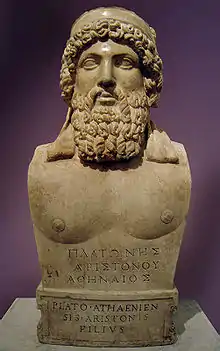
The political philosopher and professor Leo Strauss is considered by some as the prime thinker involved in the recovery of Platonic thought in its more political, and less metaphysical, form. Strauss' political approach was in part inspired by the appropriation of Plato and Aristotle by medieval Jewish and Islamic political philosophers, especially Maimonides and Al-Farabi, as opposed to the Christian metaphysical tradition that developed from Neoplatonism. Deeply influenced by Nietzsche and Heidegger, Strauss nonetheless rejects their condemnation of Plato and looks to the dialogues for a solution to what all three latter-day thinkers acknowledge as 'the crisis of the West.
W. V. O. Quine dubbed the problem of negative existentials "Plato's beard". Noam Chomsky dubbed the problem of knowledge Plato's problem. One author calls the definist fallacy the Socratic fallacy.[202]
More broadly, platonism (sometimes distinguished from Plato's particular view by the lowercase) refers to the view that there are many abstract objects. Still to this day, platonists take number and the truths of mathematics as the best support in favour of this view. Most mathematicians think, like platonists, that numbers and the truths of mathematics are perceived by reason rather than the senses yet exist independently of minds and people, that is to say, they are discovered rather than invented.[203]
Contemporary platonism is also more open to the idea of there being infinitely many abstract objects, as numbers or propositions might qualify as abstract objects, while ancient Platonism seemed to resist this view, possibly because of the need to overcome the problem of "the One and the Many". Thus e. g. in the Parmenides dialogue, Plato denies there are Forms for more mundane things like hair and mud. However, he repeatedly does support the idea that there are Forms of artifacts, e. g. the Form of Bed. Contemporary platonism also tends to view abstract objects as unable to cause anything, but it is unclear whether the ancient Platonists felt this way.
See also
| Library resources about Plato |
| By Plato |
|---|
Philosophy
- Socratic Problem
- Platonic Academy
- Plato's unwritten doctrines
- List of speakers in Plato's dialogues
- Commentaries on Plato
- Neoplatonism
- Academic Skepticism
Ancient scholarship
- Philip of Opus, Plato's amanuensis
- Aristotle
- Aristonymus, Plato's friend and student whom he sent in his stead as lawgiver of Megalopolis in Arcadia
- Python and Heraclides of Aenus, students of Plato who assassinated the tyrannical ruler of Thrace, Cotys I
- Speusippus, Plato's nephew and the second scholarch of the Academy
- Menedemus of Pyrrha
- Xenocrates
- Crantor
- Polemon
- Crates of Athens
- Arcesilaus
- Carneades
- Plotinus, founder of Neoplatonism, although he had no connection to the previous Academy of Plato
- Proclus
- Ammonius Saccas
- Thrasyllus of Mendes, editor of Plato's works
Medieval scholarship
- Yahya Ibn al-Batriq, Syrian scholar and associate of Al-Kindi who translated Timaeus into Arabic
- Hunayn ibn Ishaq, Arab scholar who either amended or surpassed the Timaeus of al-Batriq and translated Plato's Republic and Laws into Arabic
- Ishaq ibn Hunayn, translated Plato's Sophist with the commentary of Olympiodorus the Younger
- Yahya ibn Adi, translated Laws into Arabic
- Al-Farabi, author of a commentary on Plato's political philosophy
- Averroes, author of a commentary on the Republic
Modern scholarship
- Marsilio Ficino, Italian scholar and first translator of Plato's complete works into Latin
- Stephanus pagination, the standard reference numbering in Platonic scholarship, based on the 1578 complete Latin translation by Jean de Serres, and published by Henri Estienne
- Johann Gottfried Stallbaum, major Plato scholar and commentator in Latin
- Eduard Zeller, scholar and classicist
- Ulrich von Wilamowitz-Moellendorff, Plato scholar and classicist
- John Alexander Stewart, major Plato scholar and classicist
- Victor Cousin, scholar and the first translator Plato's complete works into French
- Émile Saisset, scholar and a translator Plato's complete works into French
- Émile Chambry, scholar and a translator Plato's complete works into French
- Pentti Saarikoski, translator into Finnish
- Friedrich Schleiermacher, philologist and the first to translate Plato's complete works into German
- Otto Apelt, scholar and translator Plato's complete works into German
- Benjamin Jowett, scholar and the first translated Plato's complete works into English
- Lewis Campbell, scholar and author of commentaries
- Martin Heidegger, philosopher and author of a commentary on Plato's Sophist
- James Adam, major Plato scholar and author of the authoritative critical edition of the Republic
- John Burnet, major Plato scholar and translator
- Francis Macdonald Cornford, translator of Republic and author of commentaries
- Reginald Hackforth, classical scholar and translator of Phaedrus
- William Keith Chambers Guthrie, classical scholar and historian
- E. R. Dodds, classical scholar and author of commentaries on Plato
- Thomas Taylor, classical scholar and translator
- Édouard des Places, classical philologist, and translator of Plato's Laws in French
- Allan Bloom, major Plato scholar and translator of Republic in English
- Myles Burnyeat, major Plato scholar
- Harold F. Cherniss, major Plato scholar
- Guy Cromwell Field, Plato scholar
- Paul Friedländer, Plato scholar
- Terence Irwin, major Plato scholar
- Richard Kraut, major Plato scholar
- Ellen Francis Mason, translator of Plato
- Eric Havelock, Plato scholar
- Debra Nails, Plato scholar
- Alexander Nehamas, major Plato scholar
- Thomas Pangle, major Plato scholar and translator of Laws in English
- Eugène Napoleon Tigerstedt, major Plato scholar
- Paul Shorey, major Plato scholar and translator of Republic
- John Madison Cooper, major Plato scholar and translator of several works of Plato, and editor of the Hackett edition of the complete works of Plato in English
- Leo Strauss, major Plato scholar and author of commentaries of Platonic political philosophy
- Jacob Klein, Plato scholar and author of commentaries on Meno
- Seth Benardete, major Plato scholar
- Gregory Vlastos, major Plato scholar
- Hans-Georg Gadamer, major Plato scholar
- Paul Woodruff, major Plato scholar
- Gisela Striker, Plato scholar
- Heinrich Gomperz, Plato scholar
- David Sedley, Plato scholar
- Gábor Betegh, Plato scholar
- Karl Albert, Plato scholar
- Herwig Görgemanns, Plato scholar
- John M. Dillon, Plato scholar
- Catherine Zuckert, Plato scholar and political philosopher
- Julia Annas, Plato scholar and moral philosopher
- John McDowell, translated Theaetetus in English
- Robin Waterfield, Plato scholar and translator in English
- Léon Robin, scholar of Ancient Greek philosophy, translator of the complete works of Plato in French
- Alain Badiou, French philosopher, loosely translated Republic in French
- Chen Chung-hwan, scholar and commentator, translated Parmenides in Chinese
- Liu Xiaofeng, scholar and commentator, translated Symposium in Chinese
- Michitaro Tanaka and Norio Fujisawa, translators of the complete works of Plato in Japanese
- Joseph Gerhard Liebes, major scholar and commentator, the first to translate Plato's complete works in Hebrew
- Margalit Finkelberg, scholar and commentator, translated Symposium in Hebrew
- Virgilio S. Almario, translated Republic to Filipino
- Roque Ferriols, translated Apology to Filipino[204]
- Mahatma Gandhi, translated Apology in Gujarati
- Zakir Husain, Indian politician and academic, translated Republic in Urdu[205]
- Pierre Hadot, scholar and author of commentaries of Plato in French
- Luc Brisson, translator and author of commentaries on several works of Plato, and editor of the complete French translations; widely considered to be the most important contemporary scholar of Plato[206]
Other
- Oxyrhynchus Papyri, including the Papyrus Oxyrhynchus 228, containing the oldest fragment of the Laches, and Papyrus Oxyrhynchus 24, that of the Book X of the Republic
- Plato's Dream, a story written in the 18th century by the French philosopher and satirist Voltaire
- Plato, a lunar impact crater on the Moon aged 3.8 billion years, named after the Greek philosopher
- PLATO (spacecraft), a proposed space telescope under development by the European Space Agency for launch in 2026, named after the Greek philosopher
Notes
- "...the subject of philosophy, as it is often conceived — a rigorous and systematic examination of ethical, political, metaphysical, and epistemological issues, armed with a distinctive method — can be called his invention."[3][4]
- "Though influenced primarily by Socrates, to the extent that Socrates is usually the main character in many of Plato's writings, he was also influenced by Heraclitus, Parmenides, and the Pythagoreans"[7]
- Diogenes Laërtius mentions that Plato "was born, according to some writers, in Aegina in the house of Phidiades, the son of Thales." Diogenes mentions as one of his sources the Universal History of Favorinus. According to Favorinus, Ariston, Plato's family, and his family were sent by Athens to settle as cleruchs (colonists retaining their Athenian citizenship), on the island of Aegina, from which the Spartans expelled them after Plato's birth there.[15] Nails points out, however, that there is no record of any Spartan expulsion of Athenians from Aegina between 431–411 BC.[16] On the other hand, at the Peace of Nicias, Aegina was silently left under Athens' control, and it was not until the summer of 411 that the Spartans overran the island.[17] Therefore, Nails concludes that "perhaps Ariston was a cleruch, perhaps he went to Aegina in 431, and perhaps Plato was born on Aegina, but none of this enables a precise dating of Ariston's death (or Plato's birth).[16] Aegina is regarded as Plato's place of birth by the Suda as well.[18]
- Apollodorus of Athens said Plato was born on the seventh day of the month Thargelion; according to this tradition the god Apollo was born this day.[19] Renaissance Platonists celebrated Plato's birth on November 7.[20] Ulrich von Wilamowitz-Moellendorff estimates that Plato was born when Diotimos was archon eponymous, namely between July 29, 428 BC and July 24, 427 BC.[21] Greek philologist Ioannis Kalitsounakis believes that he was born on May 26 or 27, 427 BC.[22][23]
- According to James Adam, some have held that "Glaucon and Adeimantus were uncles of Plato, but Zeller decides for the usual view that they were brothers."[30]
- From aristos and kleos
- A scroll by Philodemus analysed in 2019 may suggest that Plato was enslaved earlier than was previously believed.[59]
- He regarded "logistic" as appropriate for business men and men of war who "must learn the art of numbers or he will not know how to array his troops," while "arithmetic" was appropriate for philosophers "because he has to arise out of the sea of change and lay hold of true being."[71]
- Plotinus describes this in the last part of his final Ennead (VI, 9) entitled On the Good, or the One (Περὶ τἀγαθοῦ ἢ τοῦ ἑνός). Jens Halfwassen states in Der Aufstieg zum Einen' (2006) that "Plotinus' ontology—which should be called Plotinus' henology—is a rather accurate philosophical renewal and continuation of Plato's unwritten doctrine, i.e. the doctrine rediscovered by Krämer and Gaiser."
- In one of his letters (Epistolae 1612) Ficino writes: "The main goal of the divine Plato ... is to show one principle of things, which he called the One (τὸ ἕν)", cf. Montoriola 1926, p. 147.
- For a brief description of the problem see for example Gaiser 1980. A more detailed analysis is given by Krämer 1990. Another description is by Reale 1997 and Reale 1990. A thorough analysis of the consequences of such an approach is given by Szlezak 1999. Another supporter of this interpretation is the German philosopher Karl Albert, cf. Albert 1980 or Albert 1996. Hans-Georg Gadamer is also sympathetic towards it, cf. Grondin 2010 and Gadamer 1980. Gadamer's final position on the subject is stated in Gadamer 1997.
- Some use the term allegory instead of myth. This is in accordance with the practice in the specialized literature, in which it is common to find that the terms allegory and myth are used as synonyms. Nevertheless, there is a trend among modern scholars to use the term myth and avoid the term allegory, as it is considered more appropriate to the modern interpretation of Plato's writings. One of the first to initiate this trend was the Oxford University professor John Alexander Stewart, in his work The Myths of Plato.
- "The time is not long after the death of Socrates; for the Pythagoreans [Echecrates & co.] have not heard any details yet".[145]
References
- Ragland-Sullivan, Ellie (Fall 1989). "Plato's Symposium and the Lacanian Theory of Transference: Or, What Is Love?". The South Atlantic Quarterly. Duke University Press. 88: 740.
- Jones 2006.
- Kraut 2013
- "Plato and Aristotle: How Do They Differ?". Britannica. "Plato (c. 428–c. 348 BCE) and Aristotle (384–322 BCE) are generally regarded as the two greatest figures of Western philosophy".
- Michel Foucault, The Hermeneutics of the Subject, Palgrave Macmillan, 2005, p. 17.
- Whitehead 1978, p. 39.
- Brickhouse & Smith.
- Cooper, John M.; Hutchinson, D.S., eds. (1997): "Introduction."
- Cooper 1997, p. vii.
- Diogenes Laërtius, Life of Plato, III
• Nails 2002, p. 53
• Wilamowitz-Moellendorff 2005, p. 46 - The Great Books of the Western World: Plato, Biographical Note.
- Diogenes Laërtius, Life of Plato, I
- Guthrie 1986, p. 10
• Taylor 2001, p. xiv
• Wilamowitz-Moellendorff 2005, p. 47 - Apuleius, De Dogmate Platonis, 1
• Diogenes Laërtius, Life of Plato, I
• "Plato". Suda. - Diogenes Laërtius, Life of Plato, III
- Nails 2002, p. 54.
- Thucydides, 5.18
• Thucydides, 8.92 - "Plato". Suda.
- Diogenes Laërtius, Life of Plato, II
- Nails 2006, p. 1.
- Wilamowitz-Moellendorff 2005, p. 46.
- Plato at the Encyclopædia Britannica
- "Plato". Encyclopaedic Dictionary The Helios Volume V (in Greek). 1952.
- Nails 2002, p. 247.
- Nails 2002, p. 246.
- Nietzsche 1967, p. 32.
- Browne 1672.
- Cicero, De Divinatione, I, 36
- Plato, Republic 368a
• Wilamowitz-Moellendorff 2005, p. 47 - "Plato, Republic, Book 2, page 368". www.perseus.tufts.edu. Archived from the original on 21 April 2015. Retrieved 17 January 2016.
- Xenophon, Memorabilia, 3.6.1 Archived 25 December 2007 at the Wayback Machine
- Nails 2002, p. 53
• Taylor 2001, p. xiv - Plato, Charmides 158a
• Nails 2002, pp. 228–229 - Plato, Charmides 158a
• Plutarch, Pericles, IV - Plato, Gorgias 481d and 513b
• Aristophanes, Wasps, 97 Archived 25 December 2007 at the Wayback Machine - Plato, Parmenides 126c
- Guthrie 1986, p. 11.
- Kahn 1996, p. 186.
- Guthrie 1986, p. 12 (footnote).
- Sedley, David, Plato's Cratylus, Cambridge University Press 2003, pp. 21–22 Archived 3 March 2016 at the Wayback Machine.
- Diogenes Laërtius, Life of Plato, IV
- Notopoulos 1939, p. 135
- Seneca, Epistulae, VI 58:29–30; translation by Robert Mott Gummere
- Laërtius 1925, § 4.
- see Tarán 1981, p. 226.
- Apuleius, De Dogmate Platonis, 2
- Diogenes Laërtius, Life of Plato, IV
• Smith 1870, p. 393 - Diogenes Laërtius, Life of Plato, V
- Aristotle, Metaphysics, 1.987a Archived 25 December 2007 at the Wayback Machine
- Craig, Edward, ed. (1998). Routledge Encyclopedia of Philosophy. Routledge. p. 432. ISBN 978-0-415-07310-3.
- McEvoy 1984.
- Cairns 1961, p. xiii.
- Plutarch, Cimon 13
- Schmitz, Leonhard (1867), "Academus", in Smith, William (ed.), Dictionary of Greek and Roman Biography and Mythology, vol. 1, Boston, p. 5
- Robinson 1827, p. 16.
- Dillon 2003, pp. 1–3.
- Press 2000, p. 1.
- Riginos 1976, p. 73.
- Kennedy, Merrit (4 October 2019). "Ancient Greek Scroll's Hidden Contents Revealed Through Infrared Imaging". NPR.org. Archived from the original on 5 October 2019. Retrieved 5 October 2019.
- Diogenes Laërtius, Book iii, 20 Archived 28 April 2014 at the Wayback Machine
- Seneca, Epistulae, VI, 58, 31: natali suo decessit et annum umum atque octogensimum.
- Riginos 1976, p. 194.
- Schall 1996.
- Riginos 1976, p. 195.
- Metaphysics, 1.6.1 (987a)
- Tusc. Disput. 1.17.39.
- McFarlane, Thomas J. "Plato's Parmenides". Integralscience. Archived from the original on 22 February 2017. Retrieved 12 February 2017.
- George Karamanolis (2013). "Numenius". Stanford Encyclopedia of Philosophy. The Metaphysics Research Lab, Stanford University. Archived from the original on 20 October 2017. Retrieved 17 October 2017.
- R.M. Hare, Plato in C.C.W. Taylor, R.M. Hare and Jonathan Barnes, Greek Philosophers, Socrates, Plato, and Aristotle, Oxford: Oxford University Press, 1999 (1982), 103–189, here 117–119.
- Russell, Bertrand (1991). History of Western Philosophy. Routledge. pp. 120–124. ISBN 978-0-415-07854-2.
- Boyer 1991, p. 86
- Large, William. "Heraclitus". Arasite. Archived from the original on 6 March 2017. Retrieved 3 March 2017.
- John Palmer (2019). Parmenides. Stanford Encyclopedia of Philosophy. Metaphysics Research Lab, Stanford University. Archived from the original on 20 October 2017. Retrieved 18 October 2017.
- Second Letter 341c
- Strauss 1964, pp. 50–51.
- Metaphysics 987b1–11
- McPherran, M.L. (1998). The Religion of Socrates. Penn State Press. p. 268.
- "The Eleusinian Mysteries: The Rites of Demeter". World History Encyclopedia. Archived from the original on 27 April 2019. Retrieved 27 April 2019.
- Francis Cornford, 1941. The Republic of Plato. Oxford: Oxford University Press. pp. xxv.
- Aristotle, Metaphysics, Book 1. The original term is "ἓν ἐπὶ πολλῶν."
- Phaedo 105c.
- See Alcibiades 130a ("doesn’t the soul rule the body?") and 130d ("surely nothing about us has more authority than the soul").
- Plato, Timaeus 44d & 70
- Dorter 2006, p. 360.
- Jorgensen 2018 is perhaps the strongest opponent to interpretations on which Plato intends the theory literally. See Jorgensen, The Embodied Soul in Plato’s Later Thought. Cambridge: Cambridge University Press, 2018. Campbell 2022, on the other hand, represents a recent defense of the literal reading. See Campbell, "Plato's Theory of Reincarnation: Eschatology and Natural Philosophy," Review of Metaphysics 75 (4): 643-665. 2022.
- Theaetetus 156a
- Baird & Kaufmann 2008.
- Taylor 2011, pp. 176–187.
- Lee 2011, p. 432.
- Taylor 2011, p. 189.
- Fine 2003, p. 5.
- Theaetetus 201c–d
- Meno 97d–98a
- McDowell 1973, p. 230.
- Fine 1979, p. 366.
- Theaetetus 210a–b
- McDowell 1973, p. 256.
- Republic, Book IV.
- Blössner 2007, pp. 345–349.
- Republic 473c–d
- Republic 475c
- Plato, Republic 488
- Blössner 2007, p. 350.
- Republic 550b
- Republic 554a
- Republic 561a–b
- Republic 571a
- Dorter 2006, pp. 253–267.
- Phaedrus (265a–c)
- Kastely, James (2015). The Rhetoric of Plato's Republic. Chicago UP.
- Bjork, Collin (2021). "Plato, Xenophon, and the Uneven Temporalities of Ethos in the Trial of Socrates". Philosophy & Rhetoric. 54 (3): 240–262. doi:10.5325/philrhet.54.3.0240. ISSN 0031-8213. JSTOR 10.5325/philrhet.54.3.0240. S2CID 244334227.
- Bengtson, Erik (2019). The epistemology of rhetoric: Plato, doxa and post-truth. Uppsala.
- Rodriguez-Grandjean 1998.
- Reale 1990. Cf. p. 14 and onwards.
- Krämer 1990. Cf. pp. 38–47.
- Physics 209b
- Phaedrus 276c
- Seventh Letter 344c
- Seventh Letter 341c
- Seventh Letter 344d
- Elementa harmonica II, 30–31; quoted in Gaiser 1980, p. 5.
- Metaphysics 987b
- Gomperz 1931.
- Gaiser 1998.
- Apology 33d–34a
- Apology38b
- Phaedo 59b
- Theaetetus 210d
- Euthyphro 2a–b
- Meno 94e–95a
- Gorgias 521e–522a
- Republic 7.517e
- Apology 19b, c
- Chappel, Timothy. "Mythos and Logos in Plato". Open University. Retrieved 20 August 2017.
{{cite journal}}: Cite journal requires|journal=(help) - For instance, Timaeus' speech in the Timaeus is three times called a eikōs muthos (“a plausible story”) (29d2, 59c6, 68d2); it is seven times called an eikōs logos (“a plausible account”) (30b7, 48d2, 53d5–6, 55d5, 56a1, 57d6, 90e8). For discussions of the importance of this, see Campbell 2022 and Brisson 2012. Brisson, Luc “Why is the Timaeus Called an Eikōs Muthos and an Eikōs Logos?” in C. Collobert, P. Destrée, and F. J. Gonzalez (eds.), Plato and Myth: Studies on the Use and Status of Platonic Myths. Leiden: Brill, 2012, 369-391. Campbell, Douglas R. "Plato's Theory of Reincarnation: Eschatology and Natural Philosophy," Review of Metaphysics 75 (4): 643-665. 2022.
- Edelstein, Ludwig (October 1949). "The Function of the Myth in Plato's Philosophy". Journal of the History of Ideas. X (4): 463–481. doi:10.2307/2707185. JSTOR 2707185.
- For instance, Chad Jorgensen argues that Plato's eschatological accounts are "much better suited to a creative discourse aimed at capturing the imagination of a particular audience than to an attempt to describe an independently existing reality." Jorgensen, Chad. The Embodied Soul in Plato’s Later Thought. Cambridge: Cambridge University Press, 2018. The quotation is from page 199.
- Partenie, Catalin. "Plato's Myths". Stanford Encyclopedia of Philosophy. Archived from the original on 27 May 2017. Retrieved 29 October 2017.
- "Plato's The Allegory of the Cave: Meaning and Interpretation". Bachelor and Master. Archived from the original on 15 February 2017. Retrieved 25 February 2017.
- Blackburn 1996, p. 104.
- Hartz, Louis. 1984. A Synthesis of World History. Zurich: Humanity Press
- Popper 1962, p. 133.
- Lysis 213a
- Republic 3.403b
- Burnet 1911, p. 5
- Theaetetus 142c–143b
- Theaetetus 143c
- Burnet 1928a, § 177.
- CDC Reeve (Delta Kappa Epsilon Distinguished Professor of Philosophy, University of North Carolina, Chapel Hill), A Plato Reader: Eight Essential Dialogues (p. vi) Archived 24 December 2016 at the Wayback Machine, Hackett Publishing, 2012 ISBN 1-60384-917-3.
- Robin Barrow (Professor of Philosophy of Education at Simon Fraser University, Canada and Fellow of The Royal Society of Canada), Plato: Appendix 2: Notes on the authenticity and Groupings of Plato's works Archived 24 December 2016 at the Wayback Machine, Bloomsbury Publishing, 2014 ISBN 1-4725-0485-2.
- Platonic Writings/Platonic Readings (page x) Archived 23 December 2016 at the Wayback Machine (edited by CL Griswold Jr Archived 15 April 2015 at the Wayback Machine), Penn State Press, 2010 ISBN 0-271-04481-0.
- JM Cooper (Stuart Professor of Philosophy, Princeton University, 1997); DS Hutchinson, Complete Works (p. xii) Archived 1 April 2019 at the Wayback Machine, Hackett Publishing, 1997.
- H Tarrant (Professor of Classics at the University of Newcastle, New South Wales), Plato's First Interpreters Archived 24 December 2016 at the Wayback Machine, Cornell University Press, 2000 ISBN 0-8014-3792-X.
- Cooper 1997, p. xiv.
- Dodds 2004.
- See Guthrie 1986; Vlastos 1991; Penner 1992; Kahn 1996; Fine 1999b.
- Kraut 2013; Schofield 2002; and Rowe 2006.
- Bloom 1982, p. 5.
- Burnet 1928b, p. 9.
- Aristotle, Politics 1264b24-27 Archived 25 December 2007 at the Wayback Machine.
- Brandwood 1990, p. 251.
- Brandwood 1990, p. 77.
- Meinwald 1991.
- B Jowett, Menexenus: Appendix I (1st paragraph) Archived 24 September 2015 at the Wayback Machine.
- The extent to which scholars consider a dialogue to be authentic is noted in Cooper 1997, pp. v–vi.
- Brumbaugh & Wells 1989.
- Irwin 2011, pp. 64 & 74. See also Slings 1987, p. 34: "... primary MSS. together offer a text of tolerably good quality" (this is without the further corrections of other sources).
- Slings 1987, p. 31.
- Cooper 1997, pp. viii–xii.
- "Manuscripts – Philosophy Faculty Library". 2 March 2012. Archived from the original on 2 March 2012.
- Dodds 1959, pp. 35–36.
- Dodds 1959, p. 37.
- RD McKirahan, Philosophy Before Socrates: An Introduction with Texts and Commentary (2nd ed.), Hackett Publishing, 2011, p. 1 Archived 23 December 2016 at the Wayback Machine ISBN 1-60384-612-3.
- RS Brumbaugh, Plato for the Modern Age (p. 199) Archived 23 December 2016 at the Wayback Machine, University Press of America, 1991 ISBN 0-8191-8356-3.
- J Duffy Byzantine Philosophy and Its Ancient Sources: "The lonely mission of Michael Psellos" Archived 22 December 2016 at the Wayback Machine edited by K Ierodiakonou (Oxford University Press, 2004) ISBN 0-19-926971-8.
- Dodds 1959, p. 39.
- Irwin 2011, p. 71.
- Slings 2003, p. xxiii.
- J Hankins, Plato in the Italian Renaissance Vol. 1 (p. 300) Archived 23 December 2016 at the Wayback Machine, Brill, 1990 ISBN 90-04-09161-0.
- Allen 1975, p. 12.
- Platonis opera quae extant omnia edidit Henricus Stephanus, Genevae, 1578.
- Suzanne 2009.
- Cooper 1997, pp. xii & xxvii.
- Oxford Classical Texts – Classical Studies & Ancient History Series Archived 11 January 2012 at the Wayback Machine. Oxford University Press
- Cambridge Greek and Latin Classics – Series. Cambridge University Press
- Cambridge Classical Texts and Commentaries. Cambridge University Press
- Irwin 1979, pp. vi & 11.
- Dodds 1959.
- Fine 1999a, p. 482.
- Complete Works – Philosophy Archived 11 January 2012 at the Wayback Machine
- Clarendon Plato Series – Philosophy Series Archived 11 January 2012 at the Wayback Machine. Oxford University Press
- Cornell University Press : Agora Editions Archived 13 April 2012 at the Wayback Machine
- C.U. M.Smith – Brain, Mind and Consciousness in the History of Neuroscience (page 1) Archived 23 December 2016 at the Wayback Machine Springer Science & Business, 1 January 2014, 374 pages, Volume 6 of History, philosophy and theory of the life sciences SpringerLink : Bücher ISBN 94-017-8774-3 [Retrieved 27 June 2015]
- Lackner 2001, p. 21.
- See Burrell 1998 and Hasse 2002, pp. 33–45.
- Harris, Jonathan (2002). "Byzantines in Renaissance Italy". ORB: The Online Reference Book for Medieval Studies. College of Staten Island, City University of New York. Archived from the original on 30 September 2003. Retrieved 9 February 2015.
- Carrigan, Henry L. Jr. (2012) [2011]. "Cambridge Platonists". The Encyclopedia of Christian Civilization. Chichester, West Sussex: Wiley-Blackwell. doi:10.1002/9780470670606.wbecc0219. ISBN 9781405157629.
The Cambridge Platonists were an influential group of 17th century philosophers and clergy whose teachings on philosophy and theology later influenced Leibniz, Locke, the Scottish common sense philosopher Thomas Reid, and Kant. They thrived at Cambridge largely between 1633 and 1678, though their younger disciples carried their thinking into the early 18th century. They identified themselves neither with the Puritans nor the High Anglicans, and they encouraged toleration within the church. The Cambridge Platonists drew on the dualistic philosophies of mind and matter of Plato (427–347 BCE) and Plotinus (205–270 CE), contending that mind is prior to matter and that reason is superior to knowledge derived from the senses. They developed the ideas that reason and morality reside in the human mind and that reason is indeed the indwelling of God in the mind that allows individuals to judge both natural and divine revelation. This group of thinkers, who were among the first to write philosophy primarily in the English language (rather than in Latin or French), believed that the rational and the spiritual could go hand-in-hand. These philosophers taught that human nature possessed an innate tendency toward goodness and that human nature was perfectible. Humans possess free will, and they learn rationally the wisdom of practicing Christ's universal love. Thus, while the Cambridge Platonists devoted their energies to metaphysical questions regarding the immortality of the soul and the existence of God, they also attended closely to morality and the principles of daily living.
- Einstein 1949, pp. 683–684.
- De Haro, Sebastian (2020). "Science and Philosophy: A Love–Hate Relationship". Foundations of Science. 25 (2): 297–314. arXiv:1307.1244. doi:10.1007/s10699-019-09619-2. S2CID 118408281.
- Wilber, Ken (10 April 2001). Quantum Questions: Mystical Writings of the World's Great Physicists. ISBN 978-0-8348-2283-2.
- William Robert Wians, Aristotle's Philosophical Development: Problems and Prospects, p 1.
- Prior, William J. (1 January 1998). "Plato and the "Socratic Fallacy"". Phronesis. 43 (2): 97–113. doi:10.1163/15685289860511041. JSTOR 4182581. Retrieved 14 December 2020.
- Calian, Florin George (9 December 2021). Numbers, Ontologically Speaking: Plato on Numerosity. Brill. ISBN 978-90-04-46722-4.
- "Apologia ni Sokrates". Ateneo de Manila University. 17 January 2019. Retrieved 12 March 2021.
- "Rayasat Aflatoon ریاست افلاطون" – via Internet Archive.
- “Le plus grand spécialiste de Platon”.
Works cited
Primary sources (Greek and Roman)
- Apuleius, De Dogmate Platonis, I. See original text in Latin Library.
- Aristophanes, The Wasps. See original text in Perseus program.
- Aristotle, Metaphysics. See original text in Perseus program.
- Cicero, De Divinatione, I. See original text in Latin library.
 Laërtius, Diogenes (1925). . Lives of the Eminent Philosophers. Vol. 1:3. Translated by Hicks, Robert Drew (Two volume ed.). Loeb Classical Library.
Laërtius, Diogenes (1925). . Lives of the Eminent Philosophers. Vol. 1:3. Translated by Hicks, Robert Drew (Two volume ed.). Loeb Classical Library.- Plato. . Translated by Jowett, Benjamin – via Wikisource. See original text in Perseus program.
- Plato. . Translated by Jowett Benjamin – via Wikisource. See original text in Perseus program.
- Plato (1903). Parmenides. Translated by Burnet, John. Oxford University. republished by: Crane, Gregory (ed.). "Perseus Digital Library Project".
- Plato. . Translated by Jowett Benjamin – via Wikisource. See original text in Perseus program.
- Plutarch (1683) [written in the late 1st century]. . Lives. Translated by Dryden, John – via Wikisource. See original text in Perseus program.
- Seneca the Younger. . Translated by Richard Mott Gummere – via Wikisource. See original text in Latin Library.
- Thucydides. . Translated by Crawley, Richard – via Wikisource., V, VIII. See original text in Perseus program.
- Xenophon, Memorabilia. See original text in Perseus program.
Secondary sources
- Albert, Karl (1980). Griechische Religion und platonische Philosophie. Hamburg: Felix Meiner Verlag.
- Albert, Karl (1996). Einführung in die philosophische Mystik. Darmstadt: Wissenschaftliche Buchgesellschaft.
- Allen, Michael J.B. (1975). "Introduction". Marsilio Ficino: The Philebus Commentary. University of California Press. pp. 1–58.
- Baird, Forrest E.; Kaufmann, Walter, eds. (2008). Philosophic Classics: From Plato to Derrida (Fifth ed.). Upper Saddle River, New Jersey: Pearson Prentice Hall. ISBN 978-0-13-158591-1.
- Blackburn, Simon (1996). The Oxford Dictionary of Philosophy. Oxford University Press.
- Bloom, Harold (1982). Agon. Oxford: Oxford University Press.
- Blössner, Norbert (2007). "The City-Soul Analogy". In Ferrari, G.R.F. (ed.). The Cambridge Companion to Plato's Republic. Translated by G.R.F. Ferrari. Cambridge University Press.
- Borody, W.A. (1998). "Figuring the Phallogocentric Argument with Respect to the Classical Greek Philosophical Tradition". Nebula, A Netzine of the Arts and Science. 13: 1–27.
- Boyer, Carl B. (1991). Merzbach, Uta C. (ed.). A History of Mathematics (Second ed.). John Wiley & Sons. ISBN 978-0-471-54397-8.
- Brandwood, Leonard (1990). The Chronology of Plato's Dialogues. Cambridge University Press.
- Brickhouse, Thomas; Smith, Nicholas D. Fieser, James; Dowden, Bradley (eds.). "Plato". The Internet Encyclopedia of Philosophy. Retrieved 3 April 2014.
- Browne, Sir Thomas (1672). "XII". Pseudodoxia Epidemica. Vol. IV (6th ed.).
- Brumbaugh, Robert S.; Wells, Rulon S. (October 1989). "Completing Yale's Microfilm Project". The Yale University Library Gazette. 64 (1/2): 73–75. JSTOR 40858970.
- Burnet, John (1911). Plato's Phaedo. Oxford University Press.
- Burnet, John (1928a). Greek Philosophy: Part I: Thales to Plato. MacMillan.
- Burnet, John (1928b). Platonism. University of California Press.
- Cairns, Huntington (1961). "Introduction". In Hamilton, Edith; Cairns, Huntington (eds.). The Collected Dialogues of Plato, Including the Letters. Princeton University Press.
- Burrell, David (1998). "Platonism in Islamic Philosophy". In Craig, Edward (ed.). Routledge Encyclopedia of Philosophy. Vol. 7. Routledge. pp. 429–430.
- Cooper, John M.; Hutchinson, D.S., eds. (1997). Plato: Complete Works. Hackett Publishing.
- Dillon, John (2003). The Heirs of Plato: A Study of the Old Academy. Oxford University Press.
- Dodds, E.R. (1959). Plato Gorgias. Oxford University Press.
- Dodds, E.R. (2004) [1951]. The Greeks and the Irrational. University of California Press.
- Dorter, Kenneth (2006). The Transformation of Plato's Republic. Lexington Books.
- Einstein, Albert (1949). "Remarks to the Essays Appearing in this Collective Volume". In Schilpp (ed.). Albert Einstein: Philosopher-Scientist. The Library of Living Philosophers. Vol. 7. MJF Books. pp. 663–688.
- Fine, Gail (July 1979). "Knowledge and Logos in the Theaetetus". Philosophical Review. 88 (3): 366–397. doi:10.2307/2184956. JSTOR 2184956. Reprinted in Fine 2003.
- Fine, Gail (1999a). "Selected Bibliography". Plato 1: Metaphysics and Epistemology. Oxford University Press. pp. 481–494.
- Fine, Gail (1999b). "Introduction". Plato 2: Ethics, Politics, Religion, and the Soul. Oxford University Press. pp. 1–33.
- Fine, Gail (2003). "Introduction". Plato on Knowledge and Forms: Selected Essays. Oxford University Press.
- Gadamer, Hans-Georg (1980) [1968]. "Plato's Unwritten Dialectic". Dialogue and Dialectic. Yale University Press. pp. 124–155.
- Gadamer, Hans-Georg (1997). "Introduzione". In Girgenti, Giuseppe (ed.). La nuova interpretazione di Platone. Milan: Rusconi Libri.
- Gaiser, Konrad (1980). "Plato's Enigmatic Lecture 'On the Good'". Phronesis. 25 (1): 5–37. doi:10.1163/156852880x00025.
- Gaiser, Konrad (1998). Reale, Giovanni (ed.). Testimonia Platonica: Le antiche testimonianze sulle dottrine non scritte di Platone. Milan: Vita e Pensiero. First published as "Testimonia Platonica. Quellentexte zur Schule und mündlichen Lehre Platons" as an appendix to Gaiser's Platons Ungeschriebene Lehre, Stuttgart, 1963.
- Gomperz, H. (1931). "Plato's System of Philosophy". In Ryle, G. (ed.). Proceedings of the Seventh International Congress of Philosophy. London. pp. 426–431. Reprinted in Gomperz, H. (1953). Philosophical Studies. Boston: Christopher Publishing House 1953, pp. 119–124.
- Grondin, Jean (2010). "Gadamer and the Tübingen School". In Gill, Christopher; Renaud, François (eds.). Hermeneutic Philosophy and Plato: Gadamer's Response to the Philebus. Academia Verlag. pp. 139–156.
- Guthrie, W.K.C. (1986). A History of Greek Philosophy: Volume 4, Plato: The Man and His Dialogues: Earlier Period. Cambridge University Press. ISBN 978-0-521-31101-4.
- Hasse, Dag Nikolaus (2002). "Plato Arabico-latinus". In Gersh; Hoenen (eds.). The Platonic Tradition in the Middle Ages: A Doxographic Approach. De Gruyter. pp. 33–66.
- Irwin, T.H. (1979). Plato: Gorgias. Oxford University Press.
- Irwin, T.H. (2011). "The Platonic Corpus". In Fine, G. (ed.). The Oxford Handbook of Plato. Oxford University Press.
- Jones, Daniel (2006). Roach, Peter; Hartman, James; Setter, Jane (eds.). Cambridge English Pronouncing Dictionary (17 ed.). Cambridge University Press.
- Kahn, Charles H. (1996). Plato and the Socratic Dialogue: The Philosophical Use of a Literary Form. Cambridge University Press. ISBN 978-0-521-64830-1.
- Kierkegaard, Søren (1992). "Plato". The Concept of Irony. Princeton University Press. ISBN 978-0-691-02072-3.
- Krämer, Hans Joachim (1990). Catan, John R. (ed.). Plato and the Foundations of Metaphysics: A Work on the Theory of the Principles and Unwritten Doctrines of Plato with a Collection of the Fundamental Documents. State University of New York Press. ISBN 978-0-7914-0433-1.
- Lee, M.-K. (2011). "The Theaetetus". In Fine, G. (ed.). The Oxford Handbook of Plato. Oxford University Press. pp. 411–436.
- Kraut, Richard (11 September 2013). Zalta, Edward N. (ed.). "Plato". The Stanford Encyclopedia of Philosophy. Stanford University. Retrieved 3 April 2014.
- Lackner, D. F. (2001). "The Camaldolese Academy: Ambrogio Traversari, Marsilio Ficino and the Christian Platonic Tradition". In Allen; Rees (eds.). Marsilio Ficino: His Theology, His Philosophy, His Legacy. Brill.
- Meinwald, Constance Chu (1991). Plato's Parmenides. Oxford: Oxford University Press.
- McDowell, J. (1973). Plato: Theaetetus. Oxford University Press.
- McEvoy, James (1984). "Plato and The Wisdom of Egypt". Irish Philosophical Journal. 1 (2): 1–24. doi:10.5840/irishphil1984125. ISSN 0266-9080. Archived from the original on 5 December 2007. Retrieved 3 December 2007.
- Montoriola, Karl Markgraf von (1926). Briefe Des Mediceerkreises Aus Marsilio Ficino's Epistolarium. Berlin: Juncker.
- Nails, Debra (2002). The People of Plato: A Prosopography of Plato and Other Socratics. Hackett Publishing. ISBN 978-0-87220-564-2.
- Nails, Debra (2006). "The Life of Plato of Athens". In Benson, Hugh H. (ed.). A Companion to Plato. Blackwell Publishing. ISBN 978-1-4051-1521-6.
- Nietzsche, Friedrich Wilhelm (1967). "Vorlesungsaufzeichnungen". Werke: Kritische Gesamtausgabe (in German). Walter de Gruyter. ISBN 978-3-11-013912-9.
- Notopoulos, A. (April 1939). "The Name of Plato". Classical Philology. 34 (2): 135–145. doi:10.1086/362227. S2CID 161505593.
- Penner, Terry (1992). "Socrates and the Early Dialogues". In Kraut, Richard (ed.). The Cambridge Companion to Plato. Cambridge University Press. pp. 121–169.
- Meinwald, Constance. "Plato". Britannica Online.
- "Plato". Encyclopaedic Dictionary The Helios Volume XVI (in Greek). 1952.
- "Plato". Suda.
- Popper, K. (1962). The Open Society and its Enemies. Vol. 1. London: Routledge.
- Press, Gerald Alan (2000). "Introduction". In Press, Gerald Alan (ed.). Who Speaks for Plato?: Studies in Platonic Anonymity. Rowman & Littlefield. pp. 1–14.
- Reale, Giovanni (1990). Catan, John R. (ed.). Plato and Aristotle. A History of Ancient Philosophy. Vol. 2. State University of New York Press.
- Reale, Giovanni (1997). Toward a New Interpretation of Plato. Washington, DC: CUA Press.
- Riginos, Alice (1976). Platonica : the anecdotes concerning the life and writings of Plato. Leiden: E.J. Brill. ISBN 978-90-04-04565-1.
- Robinson, John (1827). Archæologica Græca (Second ed.). London: A. J. Valpy. Archived from the original on 1 July 2014. Retrieved 4 February 2017.
- Rodriguez-Grandjean, Pablo (1998). Philosophy and Dialogue: Plato's Unwritten Doctrines from a Hermeneutical Point of View. Twentieth World Congress of Philosophy. Boston.
- Rowe, Christopher (2006). "Interpreting Plato". In Benson, Hugh H. (ed.). A Companion to Plato. Blackwell Publishing. pp. 13–24.
- Schall, James V. (Summer 1996). "On the Death of Plato". The American Scholar. 65.
- Schofield, Malcolm (23 August 2002). Craig, Edward (ed.). "Plato". Routledge Encyclopedia of Philosophy. Routledge. Archived from the original on 10 October 2008. Retrieved 3 April 2014.
- Sedley, David (2003). Plato's Cratylus. Cambridge University Press.
- Slings, S.R. (1987). "Remarks on Some Recent Papyri of the Politeia". Mnemosyne. Fourth. 40 (1/2): 27–34. doi:10.1163/156852587x00030.
- Slings, S.R. (2003). Platonis Rempublicam. Oxford University Press.
- Smith, William (1870). "Plato". Dictionary of Greek and Roman Biography and Mythology.
- Strauss, Leo (1964). The City and the Man. Chicago: University of Chicago Press.
- Suzanne, Bernard (8 March 2009). "The Stephanus edition". Plato and his dialogues. Retrieved 3 April 2014.
- Szlezak, Thomas A. (1999). Reading Plato. Routledge. ISBN 978-0-415-18984-2.
- Tarán, Leonardo (1981). Speusippus of Athens. Brill Publishers.
- Tarán, Leonardo (2001). "Plato's Alleged Epitaph". Collected Papers 1962–1999. Brill Academic Publishers. ISBN 978-90-04-12304-5.
- Taylor, Alfred Edward (2001) [1937]. Plato: The Man and His Work. Courier Dover Publications. ISBN 978-0-486-41605-2.
- Taylor, C.C.W. (2011). "Plato's Epistemology". In Fine, G. (ed.). The Oxford Handbook of Plato. Oxford University Press. pp. 165–190.
- Vlastos, Gregory (1991). Socrates: Ironist and Moral Philosopher. Cambridge University Press.
- Whitehead, Alfred North (1978). Process and Reality. New York: The Free Press.
- Wilamowitz-Moellendorff, Ulrich von (2005) [1917]. Plato: His Life and Work (translated in Greek by Xenophon Armyros). Kaktos. ISBN 978-960-382-664-4.
Further reading
- Alican, Necip Fikri (2012). Rethinking Plato: A Cartesian Quest for the Real Plato. Amsterdam and New York: Editions Rodopi B.V. ISBN 978-90-420-3537-9.
- Allen, R. E. (1965). Studies in Plato's Metaphysics II. Taylor & Francis. ISBN 0-7100-3626-4
- Ambuel, David (2007). Image and Paradigm in Plato's Sophist. Parmenides Publishing. ISBN 978-1-930972-04-9
- Anderson, Mark; Osborn, Ginger (2009). Approaching Plato: A Guide to the Early and Middle Dialogues (PDF). Nashville: Belmont University.
- Arieti, James A. Interpreting Plato: The Dialogues as Drama, Rowman & Littlefield Publishers, Inc. ISBN 0-8476-7662-5
- Bakalis, Nikolaos (2005). Handbook of Greek Philosophy: From Thales to the Stoics Analysis and Fragments, Trafford Publishing ISBN 1-4120-4843-5
- Barrow, Robin (2007). Plato: Continuum Library of Educational Thought. Continuum. ISBN 978-0-8264-8408-6.
- Cadame, Claude (1999). Indigenous and Modern Perspectives on Tribal Initiation Rites: Education According to Plato, pp. 278–312, in Padilla, Mark William (editor), "Rites of Passage in Ancient Greece: Literature, Religion, Society", Bucknell University Press, 1999. ISBN 0-8387-5418-X
- Cooper, John M.; Hutchinson, D.S., eds. (1997). Plato: Complete Works. Hackett Publishing Company, Inc. ISBN 978-0-87220-349-5.
- Corlett, J. Angelo (2005). Interpreting Plato's Dialogues. Parmenides Publishing. ISBN 978-1-930972-02-5
- Durant, Will (1926). The Story of Philosophy. Simon & Schuster. ISBN 978-0-671-69500-2.
- Derrida, Jacques (1972). La dissémination, Paris: Seuil. (esp. cap.: La Pharmacie de Platon, 69–199) ISBN 2-02-001958-2
- Field, G.C. (1969). The Philosophy of Plato (2nd ed. with an appendix by Cross, R.C. ed.). London: Oxford University Press. ISBN 978-0-19-888040-0.
- Fine, Gail (2000). Plato 1: Metaphysics and Epistemology Oxford University Press, US, ISBN 0-19-875206-7
- Finley, M.I. (1969). Aspects of antiquity: Discoveries and Controversies The Viking Press, Inc., US
- Garvey, James (2006). Twenty Greatest Philosophy Books. Continuum. ISBN 978-0-8264-9053-7.
- Guthrie, W.K.C. (1986). A History of Greek Philosophy (Plato – The Man & His Dialogues – Earlier Period), Cambridge University Press, ISBN 0-521-31101-2
- Guthrie, W.K.C. (1986). A History of Greek Philosophy (Later Plato & the Academy) Cambridge University Press, ISBN 0-521-31102-0
- Havelock, Eric (2005). Preface to Plato (History of the Greek Mind), Belknap Press, ISBN 0-674-69906-8
- Hamilton, Edith; Cairns, Huntington, eds. (1961). The Collected Dialogues of Plato, Including the Letters. Princeton Univ. Press. ISBN 978-0-691-09718-3.
- Harvard University Press publishes the hardbound series Loeb Classical Library, containing Plato's works in Greek, with English translations on facing pages.
- Irvine, Andrew David (2008). Socrates on Trial: A play based on Aristophanes' Clouds and Plato's Apology, Crito, and Phaedo, adapted for modern performance. Toronto: University of Toronto Press. ISBN 978-0-8020-9783-5, 978-0-8020-9538-1
- Hermann, Arnold (2010). Plato's Parmenides: Text, Translation & Introductory Essay, Parmenides Publishing, ISBN 978-1-930972-71-1
- Irwin, Terence (1995). Plato's Ethics, Oxford University Press, US, ISBN 0-19-508645-7
- Jackson, Roy (2001). Plato: A Beginner's Guide. London: Hoder & Stroughton. ISBN 978-0-340-80385-1.
- Jowett, Benjamin (1892). [The Dialogues of Plato. Translated into English with analyses and introductions by B. Jowett.], Oxford Clarendon Press, UK, UIN:BLL01002931898
- Kochin, Michael S. (2002). Gender and Rhetoric in Plato's Political Thought. Cambridge Univ. Press. ISBN 978-0-521-80852-1.
- Kraut, Richard, ed. (1993). The Cambridge Companion to Plato. Cambridge University Press. ISBN 978-0-521-43610-6.
- LeMoine, Rebecca (2020). Plato's Caves: The Liberating Sting of Cultural Diversity. New York: Oxford University Press. ISBN 978-0190936983.
- Lilar, Suzanne (1954), Journal de l'analogiste, Paris, Éditions Julliard; Reedited 1979, Paris, Grasset. Foreword by Julien Gracq
- Lilar, Suzanne (1963), Le couple, Paris, Grasset. Translated as Aspects of Love in Western Society in 1965, with a foreword by Jonathan Griffin London, Thames and Hudson.
- Lilar, Suzanne (1967) A propos de Sartre et de l'amour , Paris, Grasset.
- Lundberg, Phillip (2005). Tallyho – The Hunt for Virtue: Beauty, Truth and Goodness Nine Dialogues by Plato: Pheadrus, Lysis, Protagoras, Charmides, Parmenides, Gorgias, Theaetetus, Meno & Sophist. Authorhouse. ISBN 978-1-4184-4977-3.
- Márquez, Xavier (2012) A Stranger's Knowledge: Statesmanship, Philosophy & Law in Plato's Statesman, Parmenides Publishing. ISBN 978-1-930972-79-7
- Melchert, Norman (2002). The Great Conversation: A Historical Introduction to Philosophy. McGraw Hill. ISBN 978-0-19-517510-3.
- Miller, Mitchell (2004). The Philosopher in Plato's Statesman. Parmenides Publishing. ISBN 978-1-930972-16-2
- Mohr, Richard D. (2006). God and Forms in Plato – and other Essays in Plato's Metaphysics. Parmenides Publishing. ISBN 978-1-930972-01-8
- Mohr, Richard D. (Ed.), Sattler, Barbara M. (Ed.) (2010) One Book, The Whole Universe: Plato's Timaeus Today, Parmenides Publishing. ISBN 978-1-930972-32-2
- Moore, Edward (2007). Plato. Philosophy Insights Series. Tirril, Humanities-Ebooks. ISBN 978-1-84760-047-9
- Nightingale, Andrea Wilson. (1995). "Genres in Dialogue: Plato and the Construct of Philosophy", Cambridge University Press. ISBN 0-521-48264-X
- Oxford University Press publishes scholarly editions of Plato's Greek texts in the Oxford Classical Texts series, and some translations in the Clarendon Plato Series.
- Patterson, Richard (Ed.), Karasmanis, Vassilis (Ed.), Hermann, Arnold (Ed.) (2013) Presocratics & Plato: Festschrift at Delphi in Honor of Charles Kahn, Parmenides Publishing. ISBN 978-1-930972-75-9
- Piechowiak, Marek (2019). Plato's Conception of Justice and the Question of Human Dignity. Peter Lang: Berlin. ISBN 978-3-631-65970-0.
- Sallis, John (1996). Being and Logos: Reading the Platonic Dialogues. Indiana University Press. ISBN 978-0-253-21071-5.
- Sallis, John (1999). Chorology: On Beginning in Plato's "Timaeus". Indiana University Press. ISBN 978-0-253-21308-2.
- Sayre, Kenneth M. (2005). Plato's Late Ontology: A Riddle Resolved. Parmenides Publishing. ISBN 978-1-930972-09-4
- Seung, T.K. (1996). Plato Rediscovered: Human Value and Social Order. Rowman and Littlefield. ISBN 0-8476-8112-2
- Smith, William. (1867). Dictionary of Greek and Roman Biography and Mythology. University of Michigan/Online version.
- Stewart, John. (2010). Kierkegaard and the Greek World – Socrates and Plato. Ashgate. ISBN 978-0-7546-6981-4
- Thesleff, Holger (2009). Platonic Patterns: A Collection of Studies by Holger Thesleff, Parmenides Publishing, ISBN 978-1-930972-29-2
- Thomas Taylor has translated Plato's complete works.
- Thomas Taylor (1804). The Works of Plato, viz. His Fifty-Five Dialogues and Twelve Epistles Archived 21 January 2021 at the Wayback Machine 5 vols
- Vlastos, Gregory (1981). Platonic Studies, Princeton University Press, ISBN 0-691-10021-7
- Vlastos, Gregory (2006). Plato's Universe – with a new Introduction by Luc Brisson, Parmenides Publishing. ISBN 978-1-930972-13-1
- Zuckert, Catherine (2009). Plato's Philosophers: The Coherence of the Dialogues, The University of Chicago Press, ISBN 978-0-226-99335-5
External links
- Works available online:
- Works by Plato in eBook form at Standard Ebooks
- Works by Plato at Perseus Project – Greek & English hyperlinked text
- Works by Plato at Project Gutenberg
- Works by or about Plato at Internet Archive
- Works by Plato at LibriVox (public domain audiobooks)

- Internet Encyclopedia of Philosophy
- Stanford Encyclopedia of Philosophy
- Other resources:
- Plato at the Indiana Philosophy Ontology Project
- Plato at PhilPapers
- . Catholic Encyclopedia. 1913.






